2021-01-14 - Nº 298
Editorial
Esta é a Newsletter Nº 298 que se apresenta com o mesmo formato que as anteriores. Se gostar da Newsletter partilhe-a!
Todas as Newsletters encontram-se indexadas no link.
Esta Newsletter tem os seguintes tópicos:
Faz hoje anos que nascia, em 1901, o matemático polaco-americano Alfred Tarski. Ele foi responsável por estudos importantes de álgebra geral, teoria da medida, lógica matemática, teoria dos conjuntos e meta-matemática. As linguagens científicas formais podem ser submetidas a um estudo mais completo pelo método semântico que ele desenvolveu. Ele trabalhou em teoria de modelos, problemas de decisão matemática e álgebra universal. Ele produziu axiomas para “consequência lógica”, trabalhou em sistemas dedutivos, a álgebra da lógica e a teoria da definibilidade. Os teóricos de grupo estudam “monstros Tarski”, grupos infinitos cuja existência parece intuitivamente impossível.
Faz também hoje 15 anos que a sonda espacial Huygens pousou em Titã, a maior lua de Saturno. Ele tinha sido libertada da nave Cassini quando a sua órbita a volta de Saturno convergiu com a trajectória de Titã a 24 de Dezembro de 2004. Nas primeiras três fotografias recebidas de Huygens na superfície de Titã, os cientistas viram o que se assemelhava a canais de drenagem, uma linha costeira, regiões inundadas cercadas por terreno elevado e uma planície coberta por grandes rochas, possivelmente de gelo. A sonda foi baptizada em homenagem a Christiaan Huygens, o astrónomo holandês que viu Titã pela primeira vez em 25 de Março de 1655, a primeira lua de Saturno a ser descoberta.
Nesta semana já se passaram 3.000 dias marcianos, ou sóis, desde que Curiosity pousou em Marte a 6 de Agosto de 2012, e o rover continua a fazer novas descobertas durante sua escalada gradual até o Monte Sharp, de 5 quilómetros de altura, a montanha que tem vindo a explorar desde 2014. Os geólogos ficaram intrigados ao ver uma série de “bancos” de rocha no panorama mais recente da missão.
Também nesta semana foi decidido pela NASA abandonar definitivamente a missão da sonda Insight de perfurar a superfície de Marte. Não tendo conseguido obter o atrito de que precisa para cavar, vai ser atribuída outra missão a esta sonda. Sendo um veiculo estacionário, ela não se consegue mover da posição onde aterrou e isto tornou ainda mais difícil esta missão.
Ainda esta semana foi anunciada conjuntamente pela Seeed e pela Beaglebone uma parceria com a líder de soluções RISC-V, StarFive, para criar o mais recente membro da série BeagleBoard.org, o BeagleV. BeagleV é a primeira placa RISC V acessível - projectada para correr Linux. A BeagleV, leva o código aberto para o próximo nível dando aos programadores mais liberdade e poder para inovar e projectar soluções líderes da indústria com um preço inicial acessível de cerca de 149 USD, que se seguirá com variantes de menor custo em lançamentos subsequentes.
Na Newsletter desta semana apresentamos diversas noticias, artigos científicos assim como projetos de maker. É apresentado o livro "Algorithms for Decision Making".
 João Alves ([email protected])
João Alves ([email protected])
O conteúdo da Newsletter encontra-se sob a licença  Creative Commons Attribution-NonCommercial-ShareAlike 4.0 International License.
Creative Commons Attribution-NonCommercial-ShareAlike 4.0 International License.
Novidades da Semana

NASA’s Curiosity Rover Reaches Its 3,000th Day on Mars
"As the rover has continued to ascend Mount Sharp, it’s found distinctive benchlike rock formations. It’s been 3,000 Martian days, or sols, since Curiosity touched down on Mars on Aug. 6, 2012, and the rover keeps making new discoveries during its gradual climb up Mount Sharp, the 3-mile-tall (5-kilometer-tall) mountain it has been exploring since 2014. Geologists were intrigued to see a series of rock “benches” in the most recent panorama from the mission. Stitched together from 122 images taken on Nov. 18, 2020, the mission’s 2,946th sol, the panorama was captured by the Mast Camera, or Mastcam, which serves as the rover’s main “eyes.” Toward the center of the panorama is the floor of Gale Crater, the 96-mile-wide (154 kilometer-wide) bowl that Mount Sharp sits within. On the horizon is the north crater rim. To the right is the upper part of Mount Sharp, which has rock layers that were shaped by lakes and streams billions of years ago." [...]
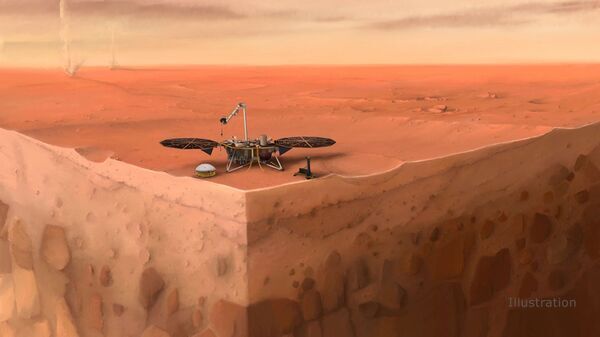
NASA InSight’s ‘Mole’ Ends Its Journey on Mars
"The heat probe hasn’t been able to gain the friction it needs to dig, but the mission has been granted an extension to carry on with its other science. The heat probe developed and built by the German Aerospace Center (DLR) and deployed on Mars by NASA’s InSight lander has ended its portion of the mission. Since Feb. 28, 2019, the probe, called the “mole,” has been attempting to burrow into the Martian surface to take the planet’s internal temperature, providing details about the interior heat engine that drives the Mars’ evolution and geology. But the soil’s unexpected tendency to clump deprived the spike-like mole of the friction it needs to hammer itself to a sufficient depth. After getting the top of the mole about 2 or 3 centimeters under the surface, the team tried one last time to use a scoop on InSight’s robotic arm to scrape soil onto the probe and tamp it down to provide added friction. After the probe conducted 500 additional hammer strokes on Saturday, Jan. 9, with no progress, the team called an end to their efforts." [...]

BeagleBoard.org® and Seeed Introduce the First Affordable RISC-V Board Designed to Run Linux
"Seeed and BeagleBoard.org® have announced an official collaboration with the leading RISC-V solutions provider, StarFive, to create the latest member of the BeagleBoard.org® series, BeagleV™ (pronounced Beagle five.) BeagleV™ is the first affordable RISC-V board designed to run Linux. BeagleV™, pushes open-source to the next level and gives developers more freedom and power to innovate and design industry leading solutions with an affordable introductory price of $149 followed by lower cost variants in subsequent releases. BeagleV™ will be available for early access in March with larger availability in September. The early access version encompasses StarFive Jinghong 7100 SoC with powerful AI performance (3.5T NVDLA, 1T NNE), built-in ISP, 1 Gigabit ethernet, and a dual core 64-bit SiFive U74 RISC-V CPU with 8GB of LPDDR4 memory. It also has a dedicated hardware encoder/decoder supporting H.264 and H.265 4k@60fps, making it a perfect edge computing device with powerful AI capability." [...]
Outras Notícias

Detect problems with your Arduino projects
"This article was written by Per Tillisch, Tooling Team SW Engineer at Arduino. The Arduino team created a tool to check Arduino projects for common problems. Arduino Lint runs over 175 checks on your sketches, libraries, and boards platforms which cover specification compliance, Library Manager submission requirements, and best practices. Arduino Lint Arduino Lint is an easy-to-use, yet powerful, command line tool. Its focus is on the structure, metadata, and configuration of Arduino projects, rather than the code. Getting started Follow the installation instructions to get ready to use Arduino Lint: https://arduino.github.io/arduino-lint/latest/installation/ Now you only need to open a terminal at your project folder and run the command: arduino-lint This will automatically detect the project type and check it against the relevant rules." [...]
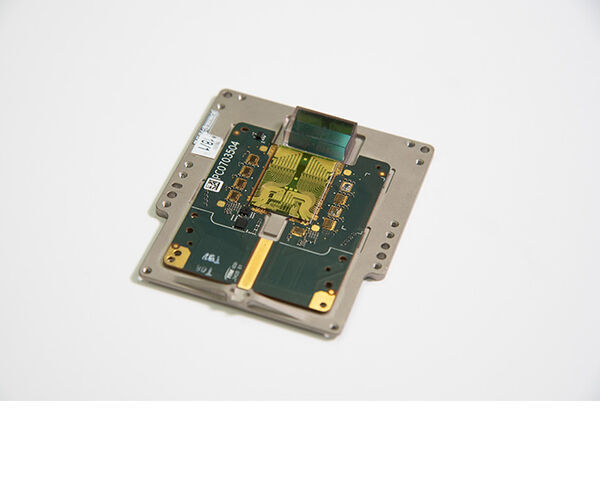
CES 2021: Mobileye Innovation Will Bring AVs to Everyone, Everywhere
"Progress Includes Automated Crowdsourced Mapping, New Lidar SoC, Software-Defined Radar and AV Test Vehicles in Four New Countries Automated, worldwide autonomous vehicle (AV) mapping capability allows Mobileye to expand its AV test fleets; new vehicles expected in Detroit, Tokyo, Shanghai, Paris and (pending regulation) New York City early this year. Intel brings its XPU strategy, expertise and manufacturing capability in silicon photonics to develop a lidar system-on-chip (SoC) for Mobileye use in AVs starting in 2025. Mobileye plans a software-defined radar customized to autonomous vehicles. Mobileye reveals that cars using its existing technology have mapped nearly 1 billion kilometers globally, with more than 8 million kilometers mapped daily. Jerusalem, Jan. 11, 2021 — Mobileye, an Intel Company, today previewed the strategy and technology that will enable autonomous vehicles (AV) to fulfill their lifesaving promise globally. During two sessions at this week’s Consumer Electronics Show, Mobileye president and chief executive officer Amnon Shashua will explain how Mobileye is set up to win globally in the AV industry." [...]

CES 2021: Intel Announces Four New Processor Families
"Delivering the Best Business, Education, Mobile and Gaming Computing Platforms for More Than 500 New PC Designs Coming in 2021 At its CES news conference, Intel highlighted how it is driving technology leadership with the introduction of more than 50 processors, resulting in more than 500 new designs for laptops and desktops coming to market in 2021. Intel launched the 11th Gen Intel® Core™ vPro® platform and Intel® Evo™ vPro® platform, delivering the highest performance and most comprehensive hardware-based security1. Intel introduced the new N-series 10-nanometer Intel® Pentium® Silver and Intel® Celeron® processors that offer an unmatched balance of performance, media and collaboration for education systems. Intel announced a new line of 11th Gen Intel® Core™ H-series mobile processors for gaming platforms that deliver an industry-leading balance of mobility and enthusiast-level gaming. Intel also previewed products coming to market later in 2021, including 11th Gen Intel® Core™ S-series desktop processors (code-named “Rocket Lake-S”) and its next-generation processors (code-named “Alder Lake”). SANTA CLARA, Calif., Jan. 11, 2021 – In a world where computing is pervasive and intelligence is distributed across every surface – from the cloud to the network to the intelligent edge – Intel today at CES 2021 highlighted how it is driving technology leadership to define the future of computing for people, business and society." [...]

IM AI: China Automaker SAIC Unveils EV Brand Powered by NVIDIA DRIVE Orin
"There’s a new brand of automotive intelligence equipped with the brains — and the battery — to go the distance. SAIC, the largest automaker in China, joined forces with etail giant Alibaba to unveil a new premium EV brand, dubbed IM, or “intelligence in motion.” The long-range electric vehicles will feature AI capabilities powered by the high-performance, energy-efficient NVIDIA DRIVE Orin compute platform. The first two vehicles in the lineup — a flagship sedan and SUV — will have autonomous parking and other automated driving features, as well as a 93kWh battery that comes standard. SAIC will begin taking orders for the sedan at the Shanghai Auto Show in April, with the SUV following in 2022. These models will have multi NVIDIA Orin SoCs (system-on-a-chip) at the core of a centralized computer system, achieving 500 to 1,000+ TOPS of performance for automated and autonomous capabilities in addition to in-cabin personalization that is continuously upgradable over-the-air for a truly software-defined experience. By centralizing and unifying the compute architecture, IM vehicles will be able to receive advanced software features as they’re developed." [...]

NVIDIA Introduces GeForce RTX 3060, Next Generation of the World’s Most Popular GPU
"NVIDIA today announced that it is bringing the NVIDIA Ampere architecture to millions more PC gamers with the new GeForce® RTX™ 3060 GPU. With its efficient, high-performance architecture and the second generation of NVIDIA RTX™, the RTX 3060 brings amazing hardware ray-tracing capabilities and support for NVIDIA DLSS and other technologies, and is priced at $329. NVIDIA’s 60-class GPUs have traditionally been the single most popular cards for gamers on Steam, with the GTX 1060 long at the top of the GPU gaming charts since its introduction in 2016. An estimated 90 percent of GeForce gamers currently play with a GTX-class GPU. “There’s unstoppable momentum behind ray tracing, which has quickly redefined the new standard of gaming,” said Matt Wuebbling, vice president of global GeForce marketing at NVIDIA. “The NVIDIA Ampere architecture has been our fastest-selling ever, and the RTX 3060 brings the strengths of the RTX 30 Series to millions more gamers everywhere.” With newer gaming titles come bigger worlds with cinematic graphics and real-time ray tracing — these are gaming workloads that only RTX-powered platforms are suited to handle." [...]

Samsung’s Newest 108Mp Mobile Image Sensor With Advanced Features Captures More Details and Produces Sharper Results
"Samsung ISOCELL HM3 comes in 0.8µm and with nine-pixel binning, providing optimum brightness and enhanced auto-focusing Smart ISO Pro and Super PD Plus fine-tune the sensor’s performance for premium mobile imaging experiences Samsung Electronics, a world leader in advanced semiconductor technology, today introduced its latest 108-megapixel (Mp) mobile image sensor, Samsung ISOCELL HM3. With a wide spectrum of advanced sensor technologies, the HM3 can capture sharper and more vivid images in ultra-high resolution with faster auto-focus and extended dynamic range. “While a pixel is just a single dot of color, when in millions, these dots can be transformed into stunning snapshots of life. With more pixels, images are sharper, with fuller details that can maintain their integrity even when enlarged. Samsung has been at the forefront of bringing the most pixels to mobile image sensors as well as various supporting technologies that take sensor performances to the next level,” said Duckhyun Chang, executive vice president of the sensor business at Samsung Electronics. “The ISOCELL HM3 is the culmination of Samsung’s latest sensor technologies that will help deliver premium mobile experiences to today’s smart-device users.” The 1/1.33” ISOCELL HM3 with 0.8μm-sized pixels is a new addition to Samsung ISOCELL’s 108Mp product line-up." [...]
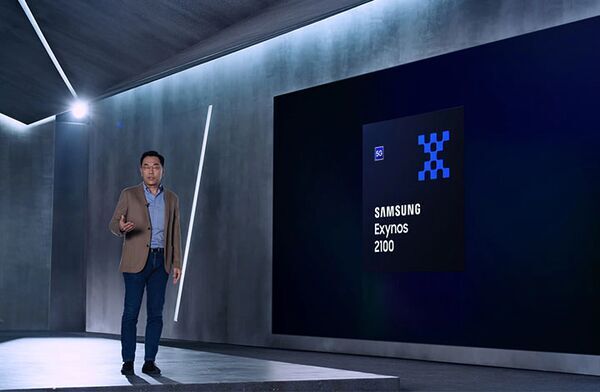
Samsung Sets New Standard for Flagship Mobile Processors With Exynos 2100
"Powerful performance and high energy-efficiency based on 5nm EUV allows elevated multitasking and gaming experiences Enhanced NPU offers major boost to AI tasks while integrated 5G capabilities deliver seamless connectivity Samsung Electronics, a world leader in advanced semiconductor technology, today announced the Exynos 2100 through its first virtual event, Exynos On 2021 (www.youtube.com/samsung). The new mobile processor is the company’s first premium 5G-integrated mobile processor built on the most advanced 5-nanometer (nm) extreme ultra-violet (EUV) process node. “Our Exynos team has been committed to creating premium mobile computing experiences by bringing innovations to processors that are at the heart of today’s smart devices,” said Inyup Kang, President of System LSI Business at Samsung Electronics. “Today we are delighted to introduce the Exynos 2100, our most advanced mobile processor yet. Armed with powerful processing technologies and an advanced 5G modem on a power-efficient 5nm process node, Exynos 2100 will set a new standard for tomorrow’s flagship mobile devices.” “At Samsung Electronics, we are dedicated to providing innovative technologies and services with our flagship devices to deliver the ultimate mobile experience to our customers,” said Kyeongjun Kim, Executive Vice President and head of Mobile R&D Office at Mobile Communications Business, Samsung Electronics. “With powerful processing, fast 5G connectivity, and intelligent AI-acceleration, the Exynos 2100 offers the utmost performance that meets the stringent quality standards and requirements for our next generation smartphone.” “The evolution of technologies such as 5G, advanced graphics and machine learning have been critical in enabling new mobile experiences,” said Paul Williamson, Vice President and General Manager, Client Line of Business at Arm." [...]

mmWave 5G TCU is Enabling New In-Vehicle Experiences
"From safety solutions that alert you of hazards while driving, to technology that allows passengers to view concerts from the comfort of their vehicles, a whole new wave of connected vehicle technologies is right around the corner. However, to enjoy various experiences on the move, vehicles must be equipped with telematics control units (TCUs) to allow faster data communication in the vehicle. As the advancement of TCU technology makes an increasing number of in-vehicle activities possible, the communications technology that allows large volumes of data to travel at faster speeds is becoming increasingly important. Samsung Electronics introduced the world’s first 5G-ready TCU in 2019, and now it has turned its attention to 5G mmWave. When it comes to providing large quantities of road information to the driver in real-time and implementing connected-car services, the ability of 5G mmWave to facilitate the transmission of large volumes of data at rapid speeds is crucial. Newsroom looks into Samsung’s innovative efforts to bring the Automotive mmWave 5G TCU to vehicles." [...]
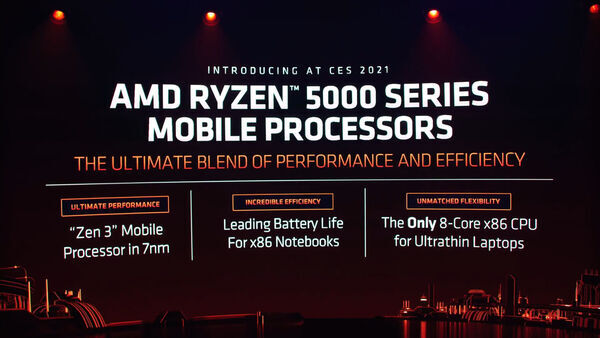
AMD Announces World’s Best Mobile Processors In CES 2021 Keynote
"Today, AMD (NASDAQ: AMD) announced the full portfolio of AMD Ryzen™ 5000 Series Mobile Processors, bringing the highly-efficient and extremely powerful “Zen 3” core architecture to the laptop market. New AMD Ryzen 5000 Series Mobile Processors provide unprecedented levels of performance and incredible battery life for gamers, creators, and professionals. New laptops powered by Ryzen 5000 Series Mobile processors will be available from major PC manufacturers including ASUS, HP and Lenovo, starting in Q1 2021. Expanding its leadership client computing product portfolio featuring the “Zen 3” core, AMD also announced the AMD Ryzen PRO 5000 Series Mobile Processors, delivering enterprise-grade security and seamless manageability to commercial users. Throughout the course of 2021, AMD expects a broad portfolio of more than 150 consumer and commercial notebooks based on the Ryzen 5000 Series Mobile Processors. “As the PC becomes an even more essential part of how we work, play and connect, users demand more performance, security and connectivity,” said Saeid Moshkelani, senior vice president and general manager, Client business unit, AMD." [...]

Microchip Releases Industry’s First 24G SAS/PCIe Gen 4 Tri-mode Storage Controllers into Production
"Smart Storage Platform delivers 3x higher performance than competing solutions Server OEMs and cloud operators designing storage platforms for next-generation data centers need to deliver significantly higher performance through PCIe® Gen 4 x16 CPU interfaces and support for the latest NVMe™ SSDs and 24G SAS infrastructure. Microchip (Nasdaq: MCHP) today announced production release of the first products to deliver these capabilities; the Smart Storage PCIe Gen 4 Tri-Mode SmartROC (RAID-on-Chip) 3200 and SmartIOC (I/O Controller) 2200 storage controllers also provide proven security and manageability features for the most demanding server storage applications. "We continue to offer the most versatile and innovative controller portfolio for an industry that is rapidly migrating to PCIe Gen4-based servers and NVMe SSDs for performance storage while continuing to leverage SAS/SATA HDDs for bulk storage,” said Pete Hazen, vice president of Microchip’s data center solutions business unit. “Our industry firsts include support for a PCIe Gen 4 interface with DirectPath technology for low-latency NVMe transactions, and 24G SAS with Dynamic Channel Multiplexing (DCM) for more efficient aggregation of lower-speed SAS or SATA hard drives onto 24G SAS infrastructure." SmartROC 3200 and SmartIOC 2200 products support both x8 and x16 PCIe Gen 4 host interfaces and up to 32 lanes of SAS/SATA/NVMe connectivity. Support for up to 8 GB of on-board cache triples the RAID performance compared to competitive alternatives, while DCM delivers link efficiency of greater than 99% while ensuring full interoperability with existing legacy SAS/SATA infrastructure." [...]

NXP Announces the BlueBox 3.0 Development Platform for Safe Automotive High-Performance Computing
"Embedded NXP Layerscape processor delivers 2x increase in processing performance over previous platform to meet new vehicle architecture demands S32G processors support ASIL D level functional safety to enable advanced safety architectures 8x increase in I/O and PCIe ports expands the platform’s connectivity and scalability, adding acceleration extensions with Kalray’s MPPA® processor-based PCIe cards to support safe Automotive High-Performance Compute applications NXP Semiconductors has announced BlueBox 3.0, a new and expanded version of NXP’s flagship safe Automotive High-Performance Compute (AHPC) development platform. Designed for software application development and validation ahead of silicon device availability, BlueBox 3.0 now offers a flexible way to address user-defined vehicles, safety Level 2+ (L2+) automated driving, and the evolving vehicle architectures that will revolutionize connected vehicles. By combining in a centralized compute module, safe integrated high-performance NXP processors, expanded I/O connectivity and extensions with Kalray’s MPPA processor-based PCIe cards enabling heterogeneous acceleration; BlueBox 3.0 offers designers a solution that can accelerate system development cycles and speed time to market. Carmakers have shifted their focus from the challenges of fully autonomous vehicles to the immediate practical opportunity to harness compute power for differentiated vehicles. User-defined vehicles allow consumers to add new functionality for today’s smart connected devices.The NXP BlueBox 3.0 delivers the rich development foundation to help designers address differentiation, safe L2+ volume production, and the associated vehicle networking architectures. “The evolution of vehicle architectures towards domain and zonal architectures is being driven by the need to address more complex requirements around user defined vehicles,” said Arnaud Van Den Bossche, Director, Global Product Marketing for eCockpit and ADAS, NXP Automotive Processing." [...]

Toshiba Introduces 5 new groups of TXZ+™ Family Advanced Class Microcontrollers that Realize Low Power Consumption, Support System Cost Reduction and Motor Control
"Toshiba Electronic Devices & Storage Corporation ("Toshiba") introduces five groups of new microcontrollers, which belong to the TXZ+™ family. The M4K, M4M, M4G, and M4N groups are based on the Arm Cortex-M4 core, and the M3H group is based on the Arm Cortex-M3 core. All groups offer low power consumption, suitable for a wide variety of applications such as motor control, connected IoT devices, leading-edge sensing functionalities, etc. Engineering samples will start to ship in the fourth quarter of FY2020 (January to March 2021) and mass production will start in the second quarter of FY2021 (July to September 2021). Associated documentation, development tools and sample software will also be provided. The advanced class has a maximum operating frequency of 200MHz, flash memory of max." [...]
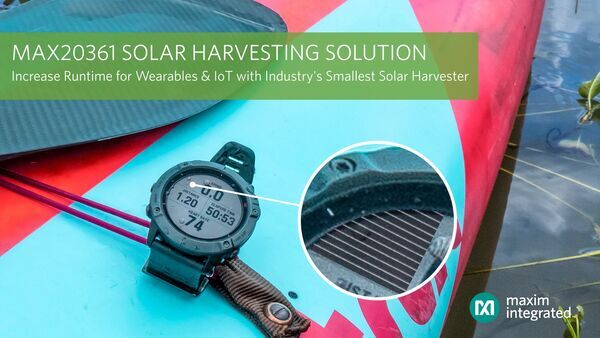
Increase the Runtime of Space-Constrained Wearable and IoT Applications with Industry’s Smallest Solar Harvesting Solution by Maxim Integrated
"MAX20361 reduces solution size by at least 50 percent while also improving harvest efficiency Designers of space-constrained designs can now significantly increase runtime with the MAX20361 single-/multi-cell solar harvester with maximum power point tracking (MPPT) from Maxim Integrated Products, Inc. (NASDAQ: MXIM). The industry’s smallest solar harvesting solution is ideal for space-constrained applications such as wearables and emerging internet of things (IoT) applications. Designers are often challenged with the tradeoff between small size and long runtime for wearable and IoT applications. By enabling solar charging in these highly space-constrained products, the MAX20361 can extend the runtime of those devices by providing a supplemental power source. This solar harvester reduces solution size by at least half compared to the closest competitor. In addition, the MAX20361 increases harvested energy with up to 5 percent better boost efficiency than the closest competitor, coupled with an adaptive MPPT approach which can improve the overall system level efficiency even further." [...]

NASA’s Juno Mission Expands Into the Future
"The spacecraft, which has been gathering data on the gas giant since July 2016, will become an explorer of the full Jovian system – Jupiter and its rings and moons. NASA has authorized a mission extension for its Juno spacecraft exploring Jupiter. The agency’s most distant planetary orbiter will now continue its investigation of the solar system’s largest planet through September 2025, or until the spacecraft’s end of life. This expansion tasks Juno with becoming an explorer of the full Jovian system – Jupiter and its rings and moons – with multiple rendezvous planned for three of Jupiter’s most intriguing Galilean moons: Ganymede, Europa, and Io. “Since its first orbit in 2016, Juno has delivered one revelation after another about the inner workings of this massive gas giant,” said principal investigator Scott Bolton of the Southwest Research Institute in San Antonio. “With the extended mission, we will answer fundamental questions that arose during Juno’s prime mission while reaching beyond the planet to explore Jupiter’s ring system and Galilean satellites.” Proposed in 2003 and launched in 2011, Juno arrived at Jupiter on July 4, 2016." [...]
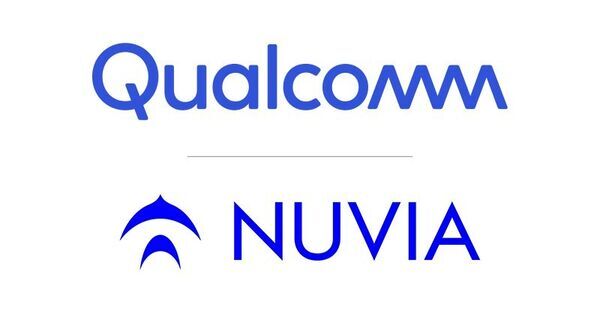
Qualcomm to Acquire NUVIA
"Qualcomm Incorporated (NASDAQ: QCOM) today announced that its subsidiary, Qualcomm Technologies, Inc., has entered into a definitive agreement to acquire NUVIA for approximately $1.4 billion before working capital and other adjustments. The transaction is subject to customary closing conditions, including regulatory approval under the Hart-Scott-Rodino Antitrust Improvements Act of 1976, as amended. 5G is further accelerating the convergence of mobility and computing. The acquisition of NUVIA builds on Qualcomm Technologies’ Snapdragon technology leadership, delivering step-function improvements in CPU performance and power efficiency to meet the demands of next-generation 5G computing. NUVIA comprises a proven world-class CPU and technology design team, with industry-leading expertise in high performance processors, Systems on a Chip (SoC) and power management for compute-intensive devices and applications. The addition of NUVIA CPUs to Qualcomm Technologies’ already leading mobile graphics processing unit (GPU), AI engine, DSP and dedicated multimedia accelerators will further extend the leadership of Qualcomm Snapdragon platforms, and positions Snapdragon as the preferred platform for the future of connected computing." [...]

SpaceX Cargo Dragon supply ship makes 1st autonomous undocking from space station
"A SpaceX Dragon cargo ship made its first-ever autonomous undocking from the International Space Station Tuesday (Jan. 12), setting the stage for a return to Earth this week. The historic event — the first undocking by an uncrewed U.S. supply ship, saw SpaceX's CRS-21 Cargo Dragon back away from the Harmony module's space port at 9:05 a.m. EST (1405 GMT). Live views on NASA Television showed the spacecraft maneuvering in orbit as it left the station as both spacecraft sailed high above the southern Atlantic Ocean. "Godspeed, Cargo Dragon and to the recovery team," NASA astronaut Victor Glover said from aboard the space station, where he monitored the spacecraft's departure. It will take about 36 hours for the SpaceX Dragon to return to Earth. The spacecraft is expected to splash down in the Gulf of Mexico on Wednesday (Jan. 13), though NASA and SpaceX will not broadcast the splashdown live." [...]

EU must 'move at speed' on space broadband network
"The European Commission says it wants its newly proposed satellite mega-constellation to be offering some sort of initial service in 2024. The first priority is to fill in gaps in broadband coverage where ground infrastructure cannot reach, but later it will power services such as self-driving cars. The project will in some ways mirror America's Starlink and the UK-Indian OneWeb networks. Its scope has yet to be fully defined. A consortium of aerospace and telecoms companies is doing that right now. But EU Internal Market Commissioner Thierry Breton said he wanted to get going on the idea as soon as possible." [...]

Mission NS-14 Successfully Demonstrates Crew Capsule Upgrades
"Mission NS-14 featured a crew capsule outfitted with astronaut experience upgrades for upcoming flights with passengers onboard. Capsule upgrades included: - Speakers in the cabin with a microphone and a push-to-talk button at each seat so astronauts can continuously talk to Mission Control. - First flight of the crew alert system with a panel at each seat relaying important safety messages to passengers. - Cushioned wall linings and sound suppression devices to reduce ambient noise inside the capsule. - Environmental systems, including a cooling system and humidity controls to regulate temperature and prevent capsule windows from fogging during flight, as well as carbon dioxide scrubbing. - Six seats." [...]
Ciência e Tecnologia

UW Researchers Turn Coal Powder into Graphite in Microwave Oven
"Using copper foil, glass containers and a conventional household microwave oven, University of Wyoming researchers have demonstrated that pulverized coal powder can be converted into higher-value nano-graphite. The discovery is another step forward in the effort to find alternative uses for Wyoming’s Powder River Basin coal, at a time when demand for coal to generate electricity is declining due to concerns about climate change. In a paper published in the journal Nano-Structures & Nano-Objects, the UW researchers report that they created an environment in a microwave oven to successfully convert raw coal powder into nano-graphite, which is used as a lubricant and in items ranging from fire extinguishers to lithium ion batteries. This “one-step method with metal-assisted microwave treatment” is a new approach that could represent a simple and relatively inexpensive coal-conversion technology. “This method provides a new route to convert abundant carbon sources to high-value materials with ecological and economic benefits,” wrote the research team, led by Associate Professor TeYu Chien, in UW’s Department of Physics and Astronomy. Others involved in the project were Professor Jinke Tang, in the Department of Physics and Astronomy; Associate Professor Brian Leonard, in the Department of Chemistry; Professor Maohong Fan, in the Department of Petroleum Engineering and the School of Energy Resources; graduate students Rabindra Dulal, of Nepal, Joann Hilman, of Laramie, Chris Masi, of Syracuse, N.Y., and Teneil Schumacher, of Buffalo; and postdoctoral researchers Gaurab Rimal, of Nepal, and Bang Xu, of China." [...]
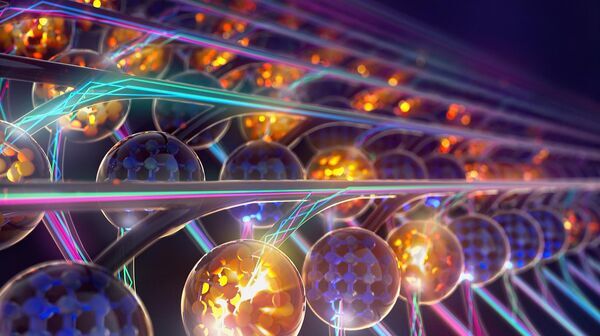
Light-carrying chips advance machine learning
"A team of international scientists has demonstrated an initial prototype of a photonic processor using tiny rays of light confined inside silicon chips that can process information much more rapidly than electronic chips and also in parallel - something traditional chips are incapable of doing. The collaborative discovery, by researchers at the Universities of Oxford, Münster, Exeter, Pittsburgh, École Polytechnique Fédérale (EPFL) and IBM Research Europe, has been published in Nature. Machine learning and artificial intelligence applications make use of vast troves of data. Our data is increasing exponentially and using this data to create information requires computer processing. The capabilities of conventional computer processors are not sufficient to keep up with this demand. This international research team has developed a new approach and processor architecture which provides a potential avenue to perform these tasks at high throughput – essentially by combining processing and data storage functionalities onto a single chip – so called in-memory processors, but using light." [...]

Titanium carbide nanotech approach hints at hydrogen storage breakthrough
"New research from China is promising to double the efficiency of hydrogen storage at a time when low-carbon collection of the omnipresent gas is seen as a potential path to a greener energy economy. Published in Nature Nanotechnology this week, the research investigated a method using a titanium carbide alloy just a few atoms thick as a medium, which produces a "nanopump" effect to store hydrogen. The process described is about twice as effective as comparable methods. Hydrogen is attracting interest as a green fuel, with fuel-cell cars already on the market. Although breakthroughs are being made in the production of the gas, storage is a critical problem owing to the tiny size of the molecule, as Register readers have been quick to point out. Work from Professor Jianglan Shui, of the School of Materials Science and Engineering, Beihang University, and his team found that the titanium carbide material (technical name Ti2CTx – a type of MXene) could support 8.8wt% (hydrogen ratio) under a "relatively safe" pressure of 60 bar." [...]
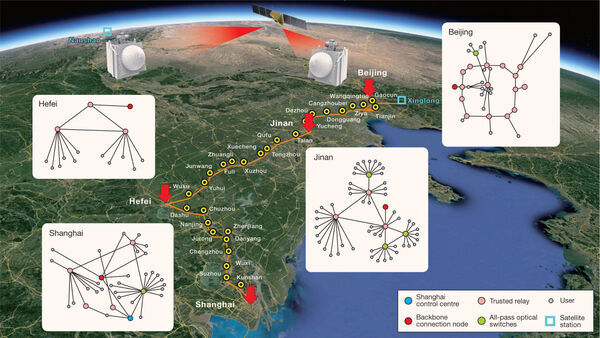
Chinese Scientists Create Integrated Quantum Communication Network
"A team of researchers in China has demonstrated an integrated space-to-ground quantum communication network that combines a large-scale fiber network of more than 700 fiber links and two high-speed satellite-to-ground free-space links. “Quantum key distribution (QKD) uses the quantum states of particles to form a string of zeros and ones, while any eavesdropping between the sender and the receiver will change this string or key and be noticed immediately,” said Professor Jianwei Pan from the University of Science and Technology of China and colleagues. “QKD has the potential to enable secure communication and information transfer.” “In the laboratory, the feasibility of point-to-point QKD is evident from the early proof-of-concept demonstration in the laboratory over 32 cm. This distance was later extended to the 100-km scale with decoy-state QKD and more recently to the 500-km scale with measurement-device-independent QKD.” “Several small-scale QKD networks were also tested outside the laboratory. However, a global QKD network requires a practically — not just theoretically — secure and reliable QKD network that can be used by a large number of users distributed over a wide area.” In 2016, China launched the world’s first quantum communication satellite — the Quantum Experiments at Space Scale (QUESS), or Mozi/Micius — and achieved QKD with two ground stations which are 2,600 km apart. A year later, an over 2,000-km-long optical fiber network was completed for QKD between Beijing and Shanghai." [...]

Hanging by a colored thread
"High-performance fibres that have been exposed to high temperatures usually lose their mechanical properties undetected and, in the worst case, can tear precisely when lives depend on them. For example, safety ropes used by fire brigades or suspension ropes for heavy loads on construction sites. Empa researchers have now developed a coating that changes color when exposed to high temperatures through friction or fire. The firefighter runs into the burning building and systematically searches room by room for people in need of rescue. Attached to him is a safety rope at the other end of which his colleagues are waiting outside in front of the building. In an emergency - should he lose consciousness for any reason - they can pull him out of the building or follow him into the building for rescue." [...]

Artificial Intelligence Solves Schrödinger’s Equation
"Scientists at Freie Universität Berlin develop a deep learning method to solve a fundamental problem in quantum chemistry A team of scientists at Freie Universität Berlin has developed an artificial intelligence (AI) method for calculating the ground state of the Schrödinger equation in quantum chemistry. The goal of quantum chemistry is to predict chemical and physical properties of molecules based solely on the arrangement of their atoms in space, avoiding the need for resource-intensive and time-consuming laboratory experiments. In principle, this can be achieved by solving the Schrödinger equation, but in practice this is extremely difficult. Up to now, it has been impossible to find an exact solution for arbitrary molecules that can be efficiently computed. But the team at Freie Universität has developed a deep learning method that can achieve an unprecedented combination of accuracy and computational efficiency. AI has transformed many technological and scientific areas, from computer vision to materials science." [...]
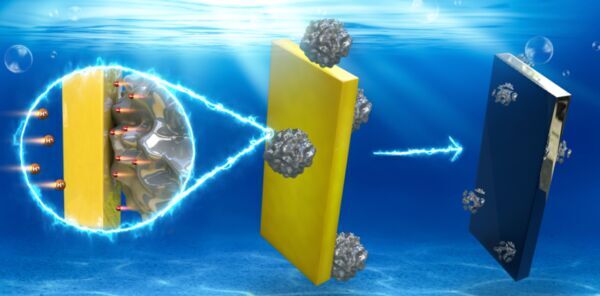
USTC Develops Ultrahigh-performance Plasmonic Metal-oxide Materials
"In a study published in Advanced Materials, the researchers from Hefei National Laboratory for Physical Sciences at the Microscale, the University of Science and Technology of China of the Chinese Academy of Sciences, using an electron–proton co-doping strategy, invented a new metal-like semiconductor material with excellent plasmonic resonance performance. This material achieves a metal-like ultrahigh free-carrier concentration that leads to strong and tunable plasmonic field. Plasmonic materials are widely used in the fields including microscopy, sensing, optical computing and photovoltaics. Most common plasmonic materials are gold and silver. Some other materials also show metal-like optical properties but just perform poor in limited wavelength ranges. In recent years, much effort has been made in finding high-performance plasmonic materials excluding noble metals." [...]

2D compound shows unique versatility
"Multifunctional nanomaterial proposed by Rice could enhance solar energy, quantum computing An atypical two-dimensional sandwich has the tasty part on the outside for scientists and engineers developing multifunctional nanodevices. An atom-thin layer of semiconductor antimony paired with ferroelectric indium selenide would display unique properties depending on the side and polarization by an external electric field. The field could be used to stabilize indium selenide’s polarization, a long-sought property that tends to be wrecked by internal fields in materials like perovskites but would be highly useful for solar energy applications. Calculations by Rice materials theorist Boris Yakobson, lead author and researcher Jun-Jie Zhang and graduate student Dongyang Zhu shows switching the material’s polarization with an external electric field makes it either a simple insulator with a band gap suitable for visible light absorption or a topological insulator, a material that only conducts electrons along its surface. Turning the field inward would make the material good for solar panels. Turning it outward could make it useful as a spintronic device for quantum computing." [...]

Gravitational Wave Search Finds Tantalizing New Clue
"An international team of scientists may be close to detecting faint ripples in space-time that fill the universe. Pairs of black holes billions of times more massive than the Sun may be circling one another, generating ripples in space itself. The North American Nanohertz Observatory for Gravitational Waves (NANOGrav) has spent more than a decade using ground-based radio telescopes to look for evidence of these space-time ripples created by behemoth black holes. This week, the project announced the detection of a signal that may be attributable to gravitational waves, though members aren't quite ready to claim success. Gravitational waves were first theorized by Albert Einstein in 1916, but they weren't directly detected until nearly a century later. Einstein showed that rather than being a rigid backdrop for the universe, space is a flexible fabric that is warped and curved by massive objects and inextricably linked with time." [...]
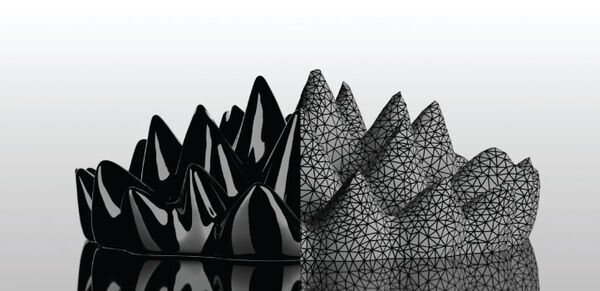
Ferrofluid surface simulations go more than skin deep
"Computer models efficiently and accurately simulate the magnetic responses of ferrofluids by considering only the fluid’s surface. The spiky structure that erupts from the smooth surface of a ferrofluid when a magnet is brought close can be predicted more accurately than previously thought. KAUST researchers have shown that computational algorithms can calculate the ferrofluid’s bristling response to a magnet by simulating only the liquid’s surface layer. Ferrofluids are liquid suspensions of iron-based particles that behave like a regular fluid, but once a magnet is present, the ferrofluid rapidly shape-shifts to form spikes that align with the magnetic field. Originally developed by NASA, ferrofluids have numerous uses ranging from advanced electronics to nanomedicine and have the potential for even broader use, if their magnetic responses could be predicted more accurately. Dominik Michels and his team are applying computer simulations to model ferrofluid behavior." [...]
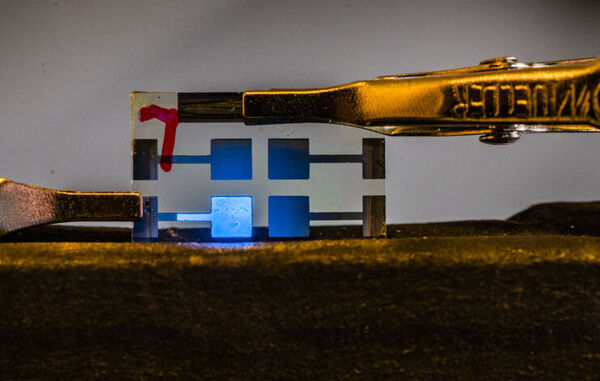
Blue-light stride in perovskite-based LEDs
"Researchers at Linköping University have developed efficient blue light-emitting diodes based on halide perovskites. “We are very excited about this breakthrough”, says Feng Gao, professor at Linköping University. The new LEDs may open the way to cheap and energy-efficient illumination. Illumination is responsible for approximately 20% of global electricity consumption, a figure that could be reduced to 5% if all light sources consisted of light-emitting diodes (LEDs). The blue-white LEDs currently in use, however, need complicated manufacturing methods and are expensive, which makes it more difficult to achieve a global transition. LEDs manufactured from halide perovskites could be a cheaper and more eco-friendly alternative for both illumination and LED-based monitors." [...]

Concept for a hybrid-electric plane may reduce aviation’s air pollution problem
"Proposed design could reduce nitrogen oxide emissions by 95 percent, a new study finds. At cruising altitude, airplanes emit a steady stream of nitrogen oxides into the atmosphere, where the chemicals can linger to produce ozone and fine particulates. Nitrogen oxides, or NOx, are a major source of air pollution and have been associated with asthma, respiratory disease, and cardiovascular disorders. Previous research has shown that the generation of these chemicals due to global aviation results in 16,000 premature deaths each year. Now MIT engineers have come up with a concept for airplane propulsion that they estimate would eliminate 95 percent of aviation’s NOx emissions, and thereby reduce the number of associated early deaths by 92 percent. The concept is inspired by emissions-control systems used in ground transportation vehicles." [...]

Neuroscientists identify brain circuit that encodes timing of events
"When we experience a new event, our brain records a memory of not only what happened, but also the context, including the time and location of the event. A new study from MIT neuroscientists sheds light on how the timing of a memory is encoded in the hippocampus, and suggests that time and space are encoded separately. In a study of mice, the researchers identified a hippocampal circuit that the animals used to store information about the timing of when they should turn left or right in a maze. When this circuit was blocked, the mice were unable to remember which way they were supposed to turn next. However, disrupting the circuit did not appear to impair their memory of where they were in space. The findings add to a growing body of evidence suggesting that when we form new memories, different populations of neurons in the brain encode time and place information, the researchers say." [...]

Robotic swarm swims like a school of fish
"Fish-inspired robots coordinate movements without any outside control Schools of fish exhibit complex, synchronized behaviors that help them find food, migrate and evade predators. No one fish or team of fish coordinates these movements nor do fish communicate with each other about what to do next. Rather, these collective behaviors emerge from so-called implicit coordination — individual fish making decisions based on what they see their neighbors doing. This type of decentralized, autonomous self-organization and coordination has long fascinated scientists, especially in the field of robotics. Now, a team of researchers at the Harvard John A. Paulson School of Engineering and Applied Sciences (SEAS) and the Wyss Institute for Biologically Inspired Engineering have developed fish-inspired robots that can synchronize their movements like a real school of fish, without any external control. It is the first time researchers have demonstrated complex 3D collective behaviors with implicit coordination in underwater robots." [...]
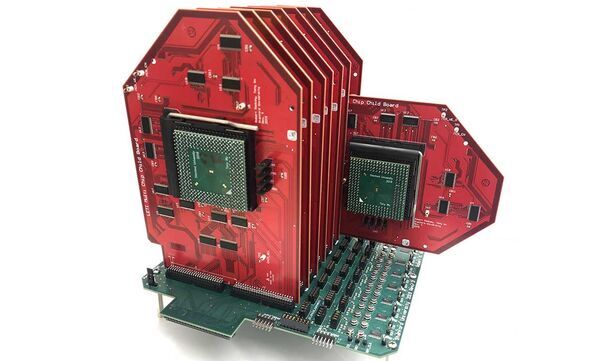
System Creates the Illusion of an Ideal AI Chip
"Team makes multiple processors with 3D memory act like one big chip What does an ideal neural network chip look like? The most important part is to have oodles of memory on the chip itself, say engineers. That’s because data transfer (from main memory to the processor chip) generally uses the most energy and produces most of the system lag—even compared to the AI computation itself. Cerebras Systems solved these problems, collectively called the memory wall, by making a computer consisting almost entirely of a single, large chip containing 18 gigabytes of memory. But researchers in France, Silicon Valley, and Singapore have come up with another way. Called Illusion, it uses processors built with resistive RAM memory in a 3D stack built above the silicon logic, so it costs little energy or time to fetch data." [...]

Stanford physicists find new state of matter in a one-dimensional quantum gas
"By adding some magnetic flair to an exotic quantum experiment, physicists produced an ultra-stable one-dimensional quantum gas with never-before-seen “scar” states – a feature that could someday be useful for securing quantum information. As the story goes, the Greek mathematician and tinkerer Archimedes came across an invention while traveling through ancient Egypt that would later bear his name. It was a machine consisting of a screw housed inside a hollow tube that trapped and drew water upon rotation. Now, researchers led by Stanford University physicist Benjamin Lev have developed a quantum version of Archimedes’ screw that, instead of water, hauls fragile collections of gas atoms to higher and higher energy states without collapsing. Their discovery is detailed in a paper published Jan. 14 in Science. “My expectation for our system was that the stability of the gas would only shift a little,” said Lev, who is an associate professor of applied physics and of physics in the School of Humanities and Sciences at Stanford." [...]
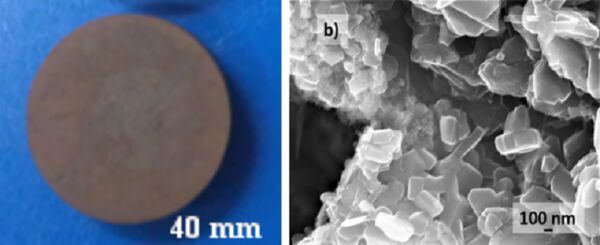
Keeping the Costs of Superconducting Magnets Down Using Ultrasound
"Scientists show ultrasonication is a cost-effective approach to enhance the properties of magnesium diboride superconductors Although magnesium diboride (MgB2) is an interesting superconductor made from abundant materials, increasing its critical current density through easily accessible means has proven challenging. In a recent study, scientists form Shibaura Institute of Technology, Japan, used ultrasonication to turn cheap commercial boron into a fine powder. With it, bulk MgB2 with enhanced superconducting properties can be produced, paving the way to affordable superconducting magnets for medical and transportation applications. Superconductivity already has a variety of practical applications, such as medical imaging and levitating transportation like the ever-popular maglev systems. However, to ensure that the benefits of applied superconductors keep spreading further into other technological fields, we need to find ways of not only improving their performance, but also making them more accessible and simpler to fabricate. In this regard, magnesium diboride (MgB2) has attracted the attention of researchers since its discovery as a superconductor with multiple advantages." [...]

New way to control electrical charge in 2D materials: Put a flake on it
"Physicists at Washington University in St. Louis have discovered how to locally add electrical charge to an atomically thin graphene device by layering flakes of another thin material, alpha-RuCl3, on top of it. A paper published in the journal Nano Letters describes the charge transfer process in detail. Gaining control of the flow of electrical current through atomically thin materials is important to potential future applications in photovoltaics or computing. “In my field, where we study van der Waals heterostructures made by custom-stacking atomically thin materials together, we typically control charge by applying electric fields to the devices,” said Erik Henriksen, assistant professor of physics in Arts & Sciences and corresponding author of the new study, along with Ken Burch at Boston College. “But here it now appears we can just add layers of RuCl3. It soaks up a fixed amount of electrons, allowing us to make ‘permanent’ charge transfers that don’t require the external electric field.” Jesse Balgley, a graduate student in Henriksen’s laboratory at Washington University, is second author of the study." [...]

Discovery of quantum behavior in insulators suggests possible new particle
"In a surprising discovery, Princeton physicists have observed an unexpected quantum behavior in an insulator made from a material called tungsten ditelluride. This phenomenon, known as quantum oscillation, is typically observed in metals rather than insulators, and its discovery offers new insights into our understanding of the quantum world. The findings also hint at the existence of an entirely new type of quantum particle. The discovery challenges a long-held distinction between metals and insulators, because in the established quantum theory of materials, insulators were not thought to be able to experience quantum oscillations. “If our interpretations are correct, we are seeing a fundamentally new form of quantum matter,” said Sanfeng Wu, assistant professor of physics at Princeton University and the senior author of a recent paper in Nature detailing this new discovery. “We are now imagining a wholly new quantum world hidden in insulators." [...]

Researchers Develop Laser-Based Process to 3D Print Detailed Glass Objects
"Multiphoton polymerization approach might one day be used to print complex optics Researchers have developed a new laser-based process for 3D printing intricate parts made of glass. With further development, the new method could be useful for making complex optics for vision, imaging, illumination or laser-based applications. “Most 3D printing processes build up an object layer by layer,” said research team leader Laurent Gallais from The Fresnel Institute and Ecole Centrale Marseille in France. “Our new process avoids the limitations of these processes by using a laser beam to transform -- or polymerize -- a liquid precursor into solid glass.” In The Optical Society (OSA) journal Optics Letters, Gallais and research team members Thomas Doualle and Jean-Claude Andre demonstrate how they used the new technique to create detailed objects in a 3D volume without using the classical layer-by-layer approach. Using this approach, they created a variety of silica glass objects such as miniature models of a bike and the Eiffel Tower without any pores or cracks. The 3D printing approach is based on multiphoton polymerization, which ensures that polymerization, a process that links liquid monomer molecules together into a solid polymer, only takes place at the precise laser focal point." [...]
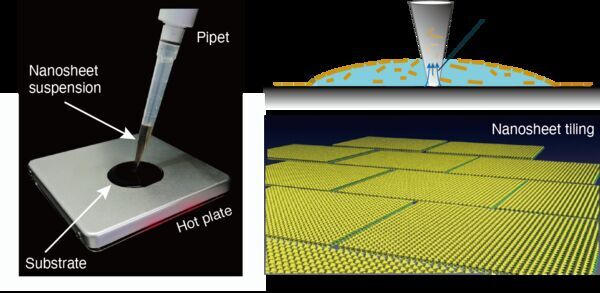
Nanosheet-based electronics could be one drop away
"A surprisingly simple method improves 'drop casting' fabrication of tiled nanosheets that could be used in next-generation electronic devices. All you need is a pipette and a hotplate. Scientists at Japan's Nagoya University and the National Institute for Materials Science have found that a simple one-drop approach is cheaper and faster for tiling functional nanosheets together in a single layer. If the process, described in the journal ACS Nano, can be scaled up, it could advance development of next-generation oxide electronics. "Drop casting is one of the most versatile and cost-effective methods for depositing nanomaterials on a solid surface," says Nagoya University materials scientist Minoru Osada, the study's corresponding author. "But it has serious drawbacks, one being the so-called coffee-ring effect: a pattern left by particles once the liquid they are in evaporates." [...]

Most Distant Quasar Discovered Sheds Light on How Black Holes Grow
"A team of astronomers led by the University of Arizona has observed the most distant quasar to date. Fully formed just 670 million years after the Big Bang and powered by the earliest known supermassive black hole, the quasar provides insight into the formation of massive galaxies in the early universe. A team of astronomers led by the University of Arizona has observed a luminous quasar 13.03 billion light-years from Earth – the most distant quasar discovered to date. Dating back to 670 million years after the Big Bang, when the universe was only 5% its current age, the quasar hosts a supermassive black hole equivalent to the combined mass of 1.6 billion suns. In addition to being the most distant – and by extension, earliest – quasar known, the object is the first of its kind to show evidence of an outflowing wind of super-heated gas escaping from the surroundings of the black hole at a fifth of the speed of light. In addition to revealing a strong quasar-driven wind, the new observations also show intense star formation activity in the host galaxy where the quasar, formally designated J0313-1806, is located." [...]

Scientists develop a cheaper method that might help create fuels from plants
"Scientists have figured out a cheaper, more efficient way to conduct a chemical reaction at the heart of many biological processes, which may lead to better ways to create biofuels from plants. Scientists around the world have been trying for years to create biofuels and other bioproducts more cheaply; this study, published today in the journal Scientific Reports, suggests that it is possible to do so. “The process of converting sugar to alcohol has to be very efficient if you want to have the end product be competitive with fossil fuels,” said Venkat Gopalan, a senior author on the paper and professor of chemistry and biochemistry at The Ohio State University. “The process of how to do that is well-established, but the cost makes it not competitive, even with significant government subsidies. This new development is likely to help lower the cost.” At the heart of their discovery: A less expensive and simpler method to create the “helper molecules” that allow carbon in cells to be turned into energy. Those helper molecules (which chemists call cofactors) are nicotinamide adenine dinucleotide (NADH) and its derivative (NADPH)." [...]
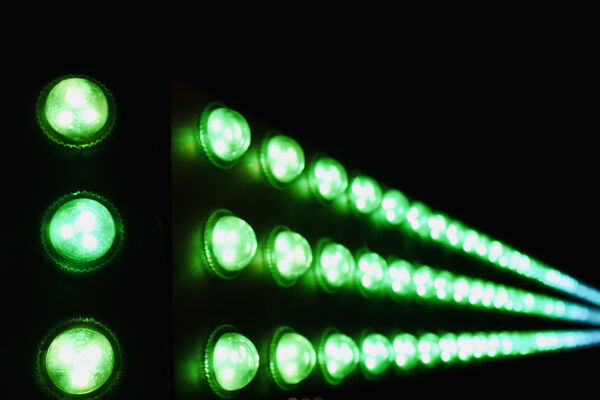
New strategies for designing electroluminescent materials
"A collaborative team of materials scientists and theoretical chemists provide hybrid perovskite nanoparticles that are high-efficiency light emitters by using a comprehensive defect-suppression strategy. New research details how a class of electroluminescent materials, key components of devices such as LED lights and solar cells, can be designed to work more efficiently. Published in Nature Photonics, the combined efforts of experimental and theoretical researchers provides insights into how these and other similar materials could be used for novel applications in the future. This work was the result of a collaboration between Penn, Seoul National University, the Korea Advanced Institute of Science and Technology, the Ecole Polytechnique Fédérale de Lausanne, the University of Tennessee, the University of Cambridge, the Universitat de Valencia, the Harbin Institute of Technology, and the University of Oxford. Two years ago, Penn theoretical chemist Andrew M. Rappe visited the lab of Tae-Woo Lee at Seoul National University, and the discussion soon turned to whether they could develop a theory to help explain some of their experimental results. The material they were studying was formamidinium lead bromide, a type of metal-halide perovskite nanocrystal (PNC)." [...]
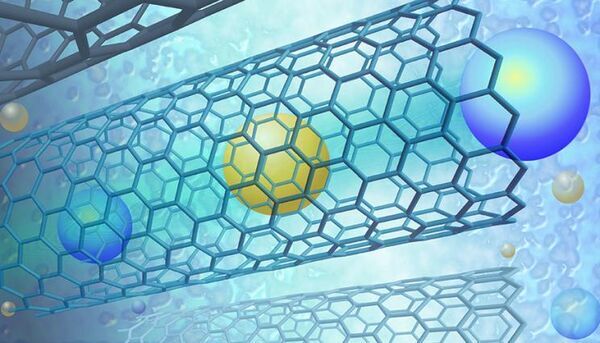
Fast transport in carbon nanotube membranes could advance human health
"Lawrence Livermore National Laboratory (LLNL) researchers have discovered that carbon nanotube membrane pores could enable ultra-rapid dialysis processes that would greatly reduce treatment time for hemodialysis patients. The ability to separate molecular constituents in complex solutions is crucial to many biological and man-made processes. One way is via the application of a concentration gradient across a porous membrane. This drives ions or molecules smaller than the pore diameters from one side of the membrane to the other while blocking anything that is too large to fit through the pores. In nature, biological membranes such as those in the kidney or liver can perform complex filtrations while still maintaining high throughput. Synthetic membranes, however, often struggle with a well-known trade-off between selectivity and permeability." [...]

Entangling electrons with heat
"Entanglement is key for quantum computing and communications technology; Aalto researchers can now extract entangled electrons using heat A joint group of scientists from Finland, Russia, China and the USA have demonstrated that temperature difference can be used to entangle pairs of electrons in normal conductors in contact with superconducting structures. The experimental discovery, published in Nature Communications, promises powerful applications in quantum devices, bringing us one step closer towards applications of the second quantum revolution. The team, led by Professor Pertti Hakonen from Aalto University, has shown that the thermoelectric effect provides a new method for producing entangled electrons in a new device. “Quantum entanglement is the cornerstone of the novel quantum technologies. This concept, however, has puzzled many physicists over the years, including Albert Einstein who worried a lot about the spooky interaction at a distance that it causes”, says Prof. Hakonen. In quantum computing, entanglement is used to fuse individual quantum systems into one, which exponentially increases their total computational capacity." [...]

Fraunhofer IOF showcasing quantum technologies for communication and microscopy
"Highly secure communication and the latest microscopy for medicine: leading-edge technologies from the world of quanta will be presented by the Fraunhofer Institute for Applied Optics and Precision Engineering IOF at the International Electronics Show CES 2021 ALL-DIGITAL from January 12 to 13. The world of light particles, the so-called "quanta of light", is very small at first glance and yet it holds gigantic potential for life in the future. Quantum physics not only holds the key to highly secure communication. Quantum-based methods for microscopy will also open doors, which have been closed up to now, in medicine and biology. Fraunhofer IOF is conducting intensive research in the underlying research fields: quantum communication as well as quantum imaging. At CES 2021, the institute will provide insights into its latest developed technologies and highly application-oriented research projects." [...]

Stanford researchers combine processors and memory on multiple hybrid chips to run AI on battery-powered smart devices
"In traditional electronics, separate chips process and store data, wasting energy as they toss data back and forth over what engineers call a “memory wall.” New algorithms combine several energy-efficient hybrid chips to create the illusion of one mega–AI chip. Smartwatches and other battery-powered electronics would be even smarter if they could run AI algorithms. But efforts to build AI-capable chips for mobile devices have so far hit a wall – the so-called “memory wall” that separates data processing and memory chips that must work together to meet the massive and continually growing computational demands imposed by AI. “Transactions between processors and memory can consume 95 percent of the energy needed to do machine learning and AI, and that severely limits battery life,” said computer scientist Subhasish Mitra, senior author of a new study published in Nature Electronics. Now, a team that includes Stanford computer scientist Mary Wootters and electrical engineer H.-S. Philip Wong has designed a system that can run AI tasks faster, and with less energy, by harnessing eight hybrid chips, each with its own data processor built right next to its own memory storage. This paper builds on the team’s prior development of a new memory technology, called RRAM, that stores data even when power is switched off – like flash memory – only faster and more energy efficiently." [...]

Computer Scientists: We Wouldn’t Be Able to Control Superintelligent Machines
"We are fascinated by machines that can control cars, compose symphonies, or defeat people at chess, Go, or Jeopardy! While more progress is being made all the time in Artificial Intelligence (AI), some scientists and philosophers warn of the dangers of an uncontrollable superintelligent AI. Using theoretical calculations, an international team of researchers, including scientists from the Center for Humans and Machines at the Max Planck Institute for Human Development, shows that it would not be possible to control a superintelligent AI. The study was published in the Journal of Artificial Intelligence Research. Suppose someone were to program an AI system with intelligence superior to that of humans, so it could learn independently. Connected to the Internet, the AI may have access to all the data of humanity." [...]
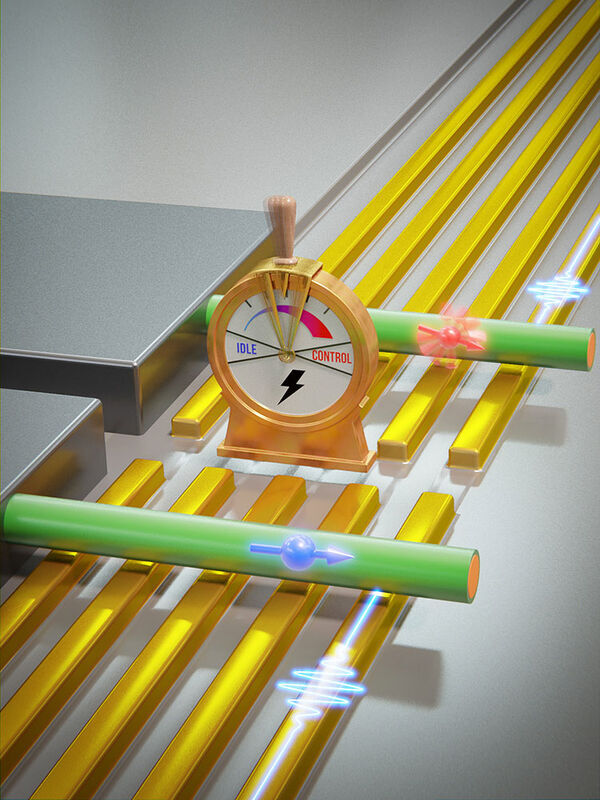
Electrically switchable qubit can tune between storage and fast calculation modes
"To perform calculations, quantum computers need qubits to act as elementary building blocks that process and store information. Now, physicists have produced a new type of qubit that can be switched from a stable idle mode to a fast calculation mode. The concept would also allow a large number of qubits to be combined into a powerful quantum computer, as researchers from the University of Basel and TU Eindhoven have reported in the journal “Nature Nanotechnology”. Compared with conventional bits, quantum bits (qubits) are much more fragile and can lose their information content very quickly. The challenge for quantum computing is therefore to keep the sensitive qubits stable over a prolonged period of time, while at the same time finding ways to perform rapid quantum operations. Now, physicists from the University of Basel and TU Eindhoven have developed a switchable qubit that should allow quantum computers to do both." [...]
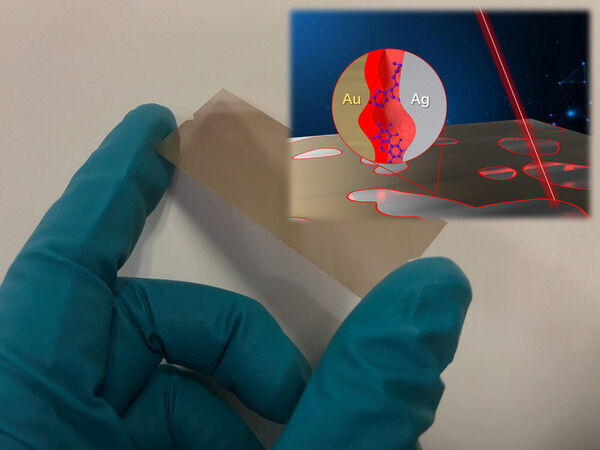
UB researchers report quantum-limit-approaching chemical sensing chip
"Study shows improvements to chemical sensing chip that aims to quickly and accurately identify drugs and other trace chemicals University at Buffalo researchers are reporting an advancement of a chemical sensing chip that could lead to handheld devices that detect trace chemicals — everything from illicit drugs to pollution — as quickly as a breathalyzer identifies alcohol. The chip, which also may have uses in food safety monitoring, anti-counterfeiting and other fields where trace chemicals are analyzed, is described in a study that appears on the cover of the Dec. 17 edition of the journal Advanced Optical Materials. “There is a great need for portable and cost-effective chemical sensors in many areas, especially drug abuse,” says the study’s lead author Qiaoqiang Gan, PhD, professor of electrical engineering in the UB School of Engineering and Applied Sciences. The work builds upon previous research Gan’s lab led that involved creating a chip that traps light at the edges of gold and silver nanoparticles. When biological or chemical molecules land on the chip’s surface, some of the captured light interacts with the molecules and is “scattered” into light of new energies. This effect occurs in recognizable patterns that act as fingerprints of chemical or biological molecules, revealing information about what compounds are present." [...]
Documentação
A documentação é parte essencial do processo de aprendizagem e a Internet além de artigos interessantes de explorar também tem alguma documentação em formato PDF interessante de ler. Todos os links aqui apresentados são para conteúdo disponibilizado livremente pelo editor do livro.

Algorithms for Decision Making
"This book provides a broad introduction to algorithms for optimal decision making under uncertainty. We cover a wide variety of topics related to decision making, introducing the underlying mathematical problem formulations and the algorithms for solving them. Figures, examples, and exercises are provided to convey the intuition behind the various approaches. This text is intended for advanced undergraduates and graduate students as well as professionals. The book requires some mathematical maturity and assumes prior exposure to multivariable calculus, linear algebra, and probability concepts. Some review material is provided in the appendix." [...]
Projetos Maker
Diversos Projetos interessantes.
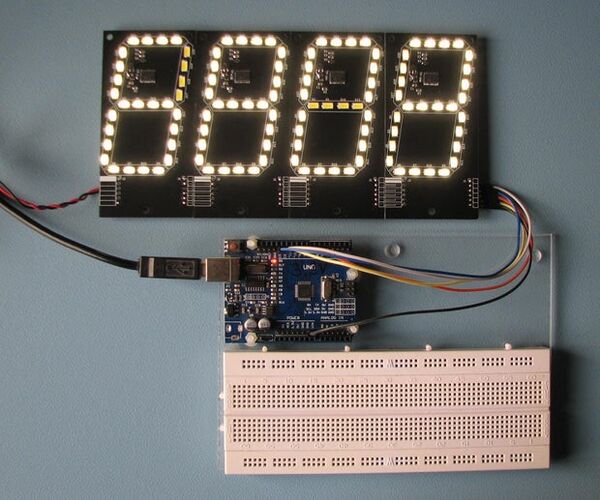
Big Seven Segment Display
"Ever since I had solar panels installed on my roof I wanted a display showing the power they generate. The setup I have can produce up to about 3 kW so four digits is needed. I want it to be visible from a few meters distant so a small LCD, OLED or LED display isn't good enough. I also has to be bright enough to be readable in bright sunlight. Of course I can go out and buy such a display but if I had done that, you wouldn't be reading this... Most devices I make are for me only and so I never bothered to design a PCB for it." [...]
Neopixel Arcade Led Game
"This is a small game made by Me {Anni Boy } using Arduino UNO in Tinkercad Circuits. You can also use real-life Arduino instead of using Tinkercad for higher performance. Follow the steps shown below... Components: 1. Arduino UNO 2. Liquid Crystal Display (LCD 16x2) 3." [...]
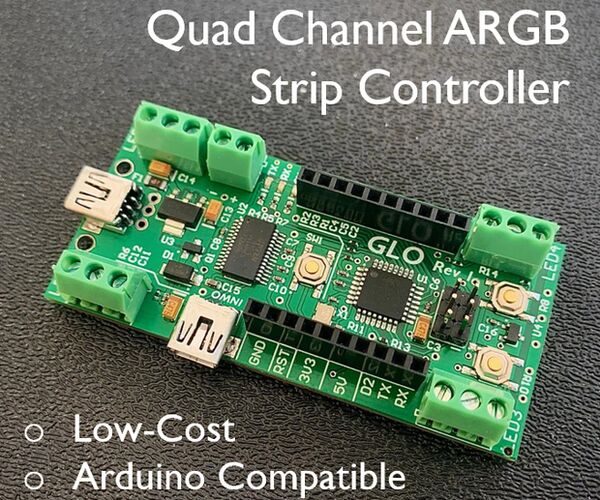
Glo: a Hackable, Arduino-Based RGB Strip/Neopixel Controller
"With LED technology and DIY Electronics being more available to everyone with each passing year, the demand for maker-friendly LED controllers has been on the rise. Currently, low-cost RGB strip drivers are available but offer no flexibility or external I/O to play with. Another option is to use an Arduino UNO or similar microcontroller. However, this approach is not suitable for more rugged/compact projects, such as mounting LEDs on a bicycle or under a car. To meet this demand, as well as to teach others the basics of RGB Lighting, I have designed Glo, a low-cost, customizable LED controller. The board is smaller than an Arduino UNO and contains all the ports needed to run multiple LED strips, eliminating the need for extra wires." [...]
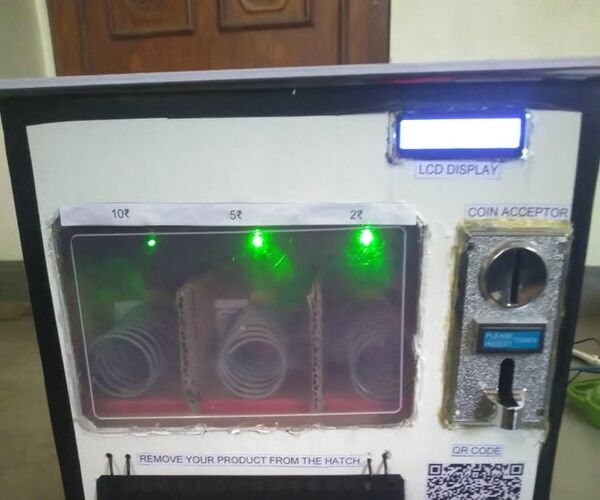
Vending Machine With Coins and Online Payments Support Using Arduino
"This is a vending machine model that is designed to accept various coins, online forms of payment like UPI and wallets(ex. Google Pay,PayTM, PhonePe, Amazon Pay etc). Nowadays, People want to avoid the hassle of carrying change and this is where online payment support is useful. It was actually my final year engineering project that was completed but was not presented due to the Covid-19 pandemic disrupting everything. I am extremely sorry for the badly recorded videos as I never got to make a proper demonstration. Supplies:For the machine casing and spiral mechanism I used foam board, cardboard, steel wire (2mm thickness), And following are the parts I used to make the device: Arduino Mega 2560 16x2 LCD display I2C for LCD display SIM800L GSM module CS 616 coin acceptor 3x geared DC motor with wheel Arduino motor shield SPST switch 3x LEDs and resistors xcluma DC-DC 12V to 3.3V 5V 12V Power Module Multi-Output Voltage Conversion Module DC jack DC 12V adapter" [...]
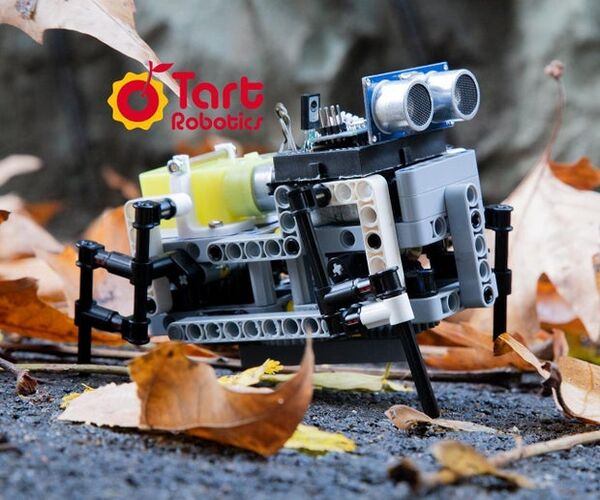
A DIY Quadruped Robot With Arduino, 3D Printed, and Lego-compatible Parts
"Introduction Legged robots have always been one of the most interesting creations in the robotic industry as they could help us in exploring mysterious lunar caves and other space exploration missions. In fact, legged robots are mobile robots with articulated leg mechanisms that provide locomotion on rough trains. As compared with wheeled robots, they can move on different terrains, although at a slower speed. Legged robots are often complicated to be made and controlled, as it requires precise control of each leg to maintain its balance. In this project, we are aiming to make a fun and easy-to-build four-legged robot with Lego-compatible and an Arduino board. To do so, we take advantage of interesting mechanical mechanisms that simulate the walking pattern of a real animal, with only one DC gear motor." [...]

Monitor CO2 and TVOC With ESP32
"Due to the epidemic of covid-19, I have to work from home. In the winter, I have to close the doors and windows. The longer I stay in, the higher levels of CO2 increases, that made me a bit dizzy and lazy. Although CO2 is a harmless gas, people in high concentrations of CO2 for a long time will be harmful to health: Around 1000 ppm, a common indoor level, you will start to experience fatigue and sleepiness; For upto 2000 ppm, you will fall into sleep and feel really tired, that cant go on any work. With prolonged exposure and increases in concentration, you may have a headache and feel physically uncomfortable. Monitoring the indoor CO2 Level may actually be more important than our common sense, so I made a CO2 monitor show the indoor CO2 level reminds me to open the door and windows timely for improving the indoor air." [...]

BackpAQ Personal Air Quality Monitor V2
"Welcome to the Instructable for the DIY BackpAQ Personal Air Quality Monitor V2! As we did in the Instructable for BackpAQ Version 1, we will build a high-quality instrument capable of measuring and monitoring the most common sources of air pollution: particulates (PM1, PM2.5, PM10) and gaseous (TVOC, eCO2). More about these in upcoming sections. The BackpAQ Project The BackpAQ project is part of a middle and high school STEM curriculum that promotes learning about and experience with the monitoring of air quality (AQ) particularly in disadvantaged communities, and drives engagement among underrepresented youth in STEM activities. Key to the program is deployment of a suite of community-based mobile air quality monitors that leverage new low-cost sensors. These handheld units can be readily assembled by advanced middle-school and high school students and other STEM-oriented youth who are motivated by interest in obtaining, understanding and sharing hyper-local air quality data." [...]
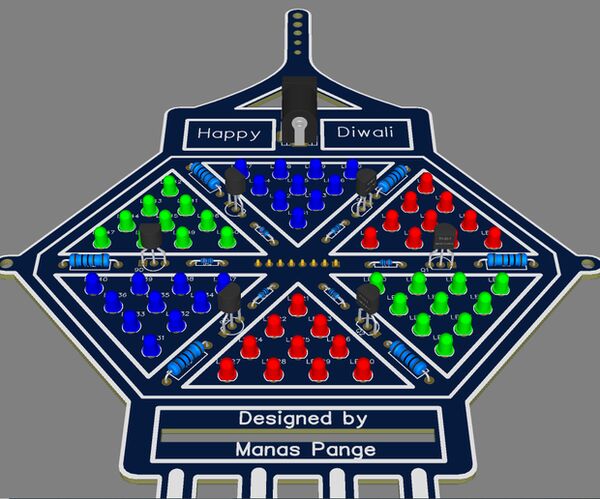
Diwali-themed Lantern Shaped PCB
"Diwali is the festival of lights. It is Indias biggest religious festival celebrated across the states. As per Hindu belief, Deepavali is the time of conquering evil by good and darkness by light. There is a special significance of the worship of goddess Lakshmi on this auspicious day. It is a belief that Goddess Lakshmi brings wealth and prosperity to the households. Supplies: 2N2222A - x6 HDR-M-2.54_1x8- x1 LED-TH-3mm_G - x20 LED-TH-3mm_R- x20 LED-TH-3mm_B- x20 Resistor 1kohm -x6 DC005-2.0MM- x1 Resistor 10ohm- x6" [...]
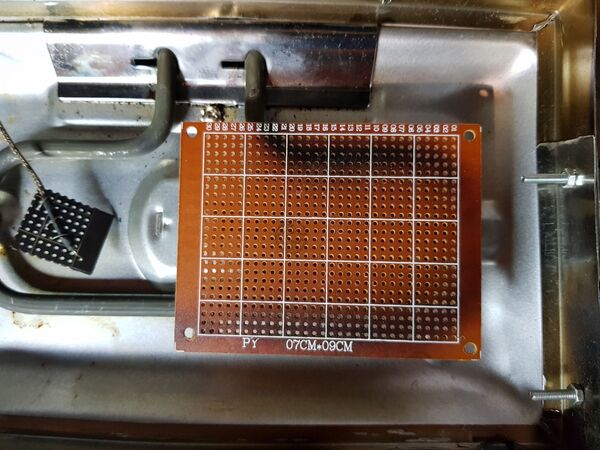
RefloWaffle: A dirt cheap reflow oven - the Belgian way
"Though I don't do many PCBs, I guess every hacker must have a reflow oven. So this is a project I've been pursuing on and off for nearly 4 years: A small, portable, and dirt cheap (less than $25) reflow oven. After a few tests with a traditional electric oven recovered from the trash, I concluded its thermal inertia was so high it would require massive modifications to achieve anything close to a decent reflow profile, and as I didn't feel like spending much money on a large oven, I looked for a better way. And I think I found it. Read on for more... The "oven" Although Belgium's national dish is fries (mistakenly called "French fries" in English), we are best known abroad for our waffles." [...]
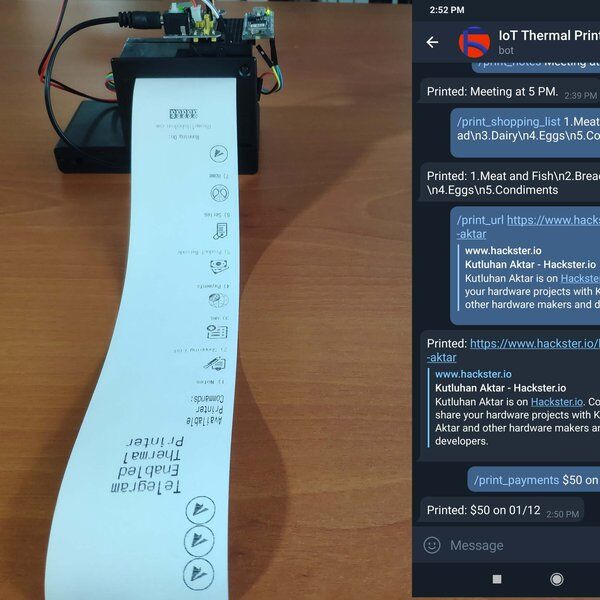
Telegram-Enabled Thermal Printer w/ Arduino
"Via Telegram, control thermal printers remotely to print out notes, shopping lists, URLs, payments, barcodes, and episode release dates. Even though we do not need handwriting or typing nowadays for taking notes or setting appointment reminders thanks to umpteen web and mobile applications, I am still fond of writing down my records on paper like in the old days :) Thus, I decided to create this project, which allows me to benefit from the advantages of an application while taking my notes and reminders on paper. Instead of programming a web and mobile application from scratch to send commands to my thermal printer, I wanted to use Telegram, a cross-platform cloud-based messaging service compatible with iOS and Android. In Telegram, it is effortless to create bots with a command list unalike any other messaging applications, which are special accounts that do not require an additional phone number to set up. IoT Thermal Printer, Telegram bot I created for this project, let me print records in six different categories I need frequently: - Notes (Appointments) - Shopping Lists - URLs - Payments - Product Barcodes (Manufacturer Product Numbers) - Series (New Episode Release Dates) To fetch commands transferred by IoT Thermal Printer, I developed an outgoing webhook for the Telegram bot, which interprets and replies commands or texts when updated by the Telegram Bot API. Then, to receive commands from the webhook and print out records with graphics (bitmaps) for each category mentioned above, I used an Arduino Nano 33 IoT and a tiny (embedded) thermal printer." [...]
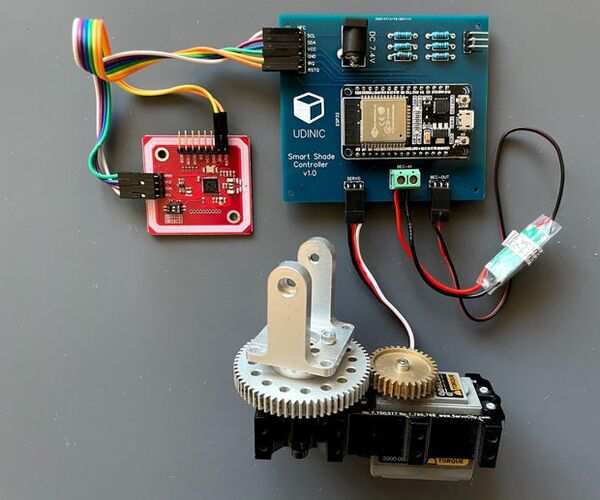
Smart Balcony Shade Using NFC
"These past few months I spent mostly at home, as everyone else, and decided to take on a project to improve my time there. I was spending a lot of time in our balcony and got really annoyed by lowering and raising the shade every day. I had to do something! Automating shades/blinds is a common project, but pretty much all the examples I found so far operated a bedroom window shade by pulling a chain or rotating a small twist shaft. My balcony shade is big and heavy, 8 feet wide and weighs 8 pounds, and it uses a crank and a wand to operate, not the typical mechanism other projects automated. I decided to challenge myself to the task!" [...]
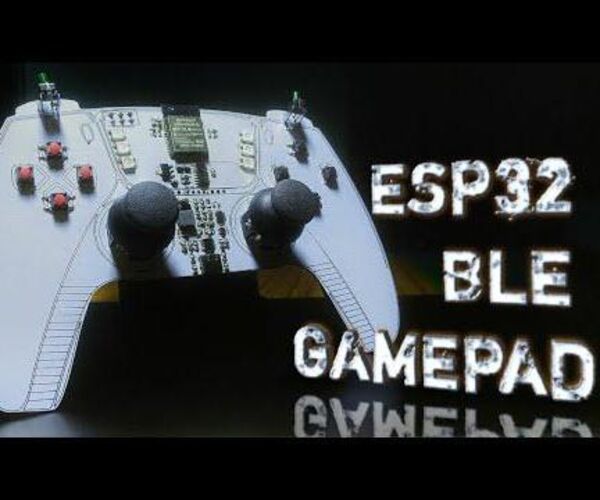
ESP32 BLE GamePad
"This is a wireless DIY Gamepad which you can use on both Android and windows to play your favorite video games. Like most of the traditional Game Controllers it has Two analog joysticks, two Trigger buttons, D-pad buttons and some LEDs. It runs on two 18650 Li-Ion battery. also there is a USB type-C port on the PCB for charging and Programming the on Board ESP32 microcontroller. Supplies: ESP32 6 ws2812b 2 Joystick 2 Angle Push Button 8 Push button 18560 battery and Battery holder 3 way toggle switch TP4056 battery charging circuit with protection MT3608 boost converter" [...]

Corona - Beginners Arduino CO2-Measuring and Ampel Display Project
"This is a project for absolute Arduino Beginners! I was an absolute Arduino Beginner a week ago, so believe me, I know! HOWEVER, if you go through this - Step-by-Step, I might be able to let you build a useful gadget for only about 25, with pretty lights, that could also help you, and someone(s) you care about, stay healthy. You might also learn a tiny little bit about cool electronics and you might learn a tiny little bit of programming. At the same time, you might also see that programming is actually really fun and kids stuff and that anybody (even me) can do it and does it every day anyway - like when you tell a friend how to put together the LEGOs for a cool toy or how to cook a great meal! When you see how easy it is, you might actually go on to bigger projects, like a robot that will put the LEGOs together for you." [...]

How to Build a 30 Kilovolt Wimshurst Machine!
"*Figure numbers for pictures are shown once you open up the picture in the top left cornerThe Wimshurst Machine belongs to a class of electrostatic generators called influence machines, which separated electric charges through electrostatic induction or influence. Electrostatic machines create high-voltage charges without the familiar coils of copper wire, permanent magnets, and commutators found in conventional generators. Theyre made of brass, glass, and wood, and they look more mechanical than electrical. The coolest thing about these generators is that you can feel them working. As you crank a Wimshurst Machine, you can hear it crackle with energy, you can smell the sharp tang of ozone, and you can feel the hair on your arms stand up as the Leyden jars begin to charge. James Wimshurst invented the Wimshurst Machine in the late 1800s." [...]

Digital Measuring Roller Using Microbit & Tinkercad
"Are you bored of the old clunky measuring tape with which you can't even measure the circumference of any cylindrical object nor it converts the units and also it has a restricted length which can be measured with it. So in this Instructables with the help for few blocks of code and some 3D printed parts we will try to make a digital measuring roller which will overcome all these issues. Upcoming steps will show the working principle and explanation of the code used if you are eager to build the device then you can skip down to step number 8 for build instructions. Supplies: 1 x Micro Bit 1 x Micro Bit Breadboard Adapter 2 x AAA Battery 1 x M3/M2.5 Bolt 4 x 2mm Screws 1 x 623 Bearing(3mm x 10mm x 4mm) 1 x Rotary Encoder 2 x 10k Ohm Resistor 10 x O-Rings(~15mm Inner Diameter) Access to a 3D Printer" [...]

Build An Am Radio Receiver!
"Hello my friends at Instructables, I hope you are having a good time meanwhile you are reading this, if it is not well... you need to put your hands to work in this AMAZING AM Radio Receiver Circuit, yeah! wanna get that almost free RF Radio waves from the air and to be listened by you ears? Well... it's showtime! Definitely it is not a super regenerative or Heterodyne Receiver, not that kind of difficult stuff for many people who doesn't care about IF frecuency, AGC, RF filters, RF Cans, Decoupling Capacitors, Multiple Trimmers into a large capacitor and thing like that haha. -And we don't use a all in one radio like the ZN414, MK484, TA7XXXX, one chip receivers in a TO-92 package, because in many places from the world is obsolete and hard to find :( Plot twist: -I tested this circuit and make some improvements on it. to listen many AM radio stations near and not very near from your home, and IT WORKS!!!" [...]
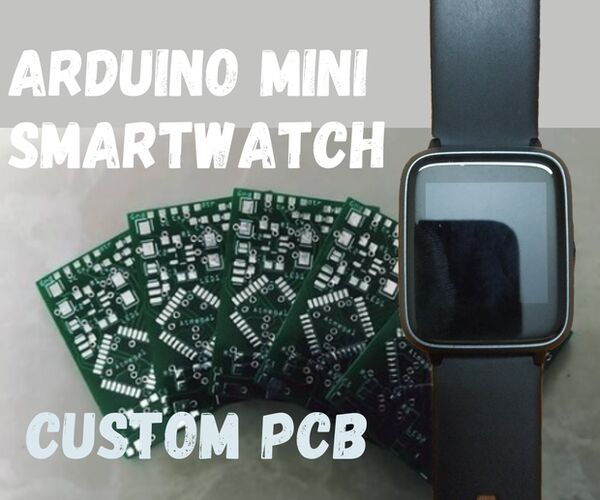
How to Make Arduino Smartwatch With Custom PCB
"Hi all, in this instructable you will see how a smartwatch can be made using an Arduino board and a few other components. We are going to design and get a custom PCB fabricated which will be the motherboard of our watch housing the main circuit and the brain of the watch ATmega 328P which we will salvage from an Arduino Nano board. I have chosen the Arduino Nano and not the more commonly used Arduino UNO because the Nano features a Surface Mount chip so it's much more compact and in this project, space is key because we need to fit all the components in the least space possible. I am going to use a 160 mAh Li-Po (Lithium Polymer) battery which will easily be able to power the watch on regular use for at least a week which is quite good enough. We will use a USB battery charging module for charging the battery. This will also have a USB port in it to charge the battery!" [...]
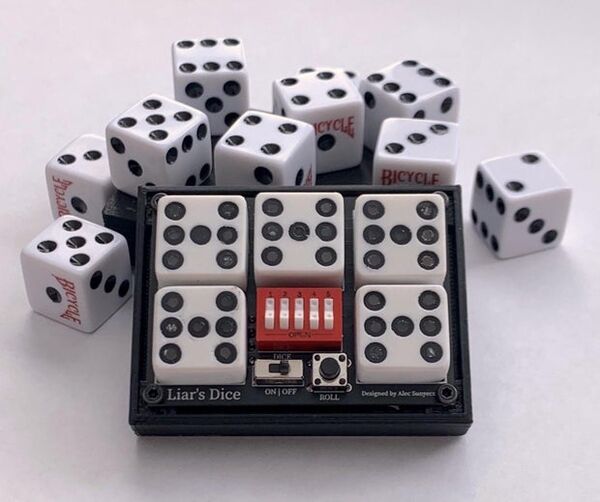
Pocket Dice! Electronic Dice for Liars Dice and More
"In this instructable, I will show you how I made this set of electronic dice. This is a small handheld device that contains 5 individual die with a button that initiates a random roll. The switch is used to turn each die on or off so depending on the game one is playing, 1-5 dice can be used. The inspiration for this project came during quarantine when many of the card and board games we own were running out of fun. For something different, I wanted to play a dice game called Liars Dice which is a fun, strategic, betting game. The problem is that each player needs 5 dice and a place to roll/cover their die." [...]
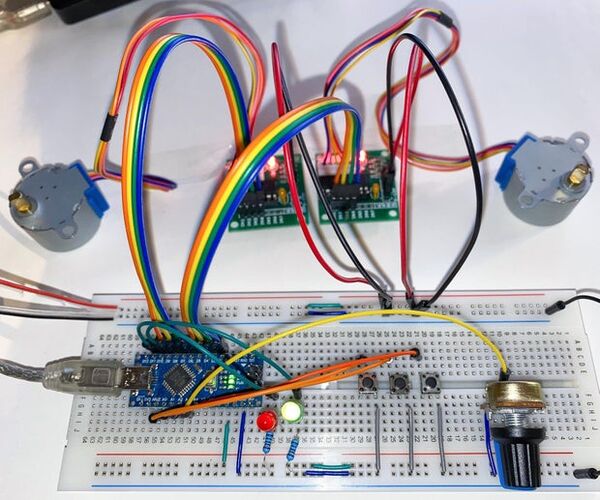
Synchronized 2-Axis Motion With Variable Speed (Arduino + LEDs + 28BYJ-48)
"This tutorial shows how to move two stepper motors so they will synchronously arrive at defined destination point. There are many sophisticated solutions for doing this such as GRBL or Marlin. Using an Arduino, there are also dedicated Multi Stepper libraries that can support you. However, we will use a more basic approach here making it as easy as possible while adding a simple user interface using either three LEDs and some microswitches. Supplies: 1 Arduino Nano (or Uno, with 328P CPU) 1 Breadboard (830 Holes) 14 Jumper Cables (male-to-male, 10 ... 20 cm) 12 Jumper Cables (male to-female, 10...20 cm) 2 LEDs (5mm, 20mA, around 2V) 2 Resistors (220 Ohm) 2 Microswitches 1 Potentionmeter (5 or 10 kOhm) 1 5V Power Supply 2 28BYJ-48 Stepper Motors (5V Version) + ULN 2003 Driver Boards" [...]
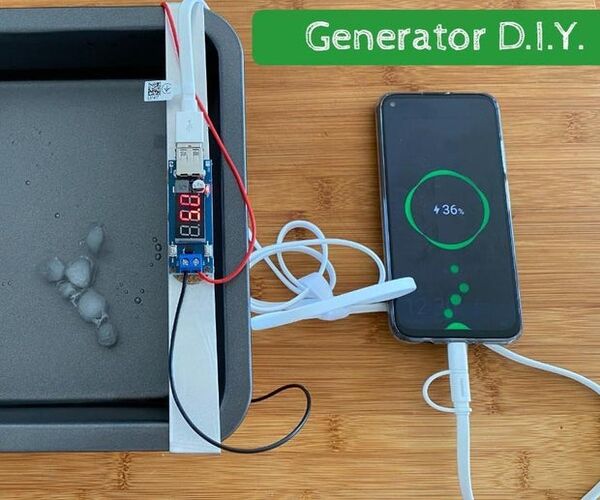
Thermoelectric Generator DIY
"Hi everyone! This Instructable will help you building your own Thermoelectric Generator using thermoelectric coolers (a.k.a. TEC). If you follow each and every step of this tutorial you will be able to generate energy with nothing but fire and water! What you are going to learn from this Instructable: How TEC work Use TEC to generate energy How to build a Thermoelectric Generator How to take advantage of the Seebeck effect Make fun experiments with TEC ( making ICE and power a MOTOR) Make sure you watch the video because it´s more illustrative. Subscribe to my Youtube channel so you don´t miss out on new project and to help me grow!" [...]
Neopixel Charcuterie Board
"I love addressable LED lights and while brainstorming ideas for ways to use them I decided I wanted to try using epoxy resin to make a charcuterie board. The plan was to dye the epoxy white to have an opaque finish that would defuse the LEDs. Even though things didn't go exactly as planned, I feel that it is worth it to share my process to inspire others and hopefully anyone who tries this can get a better result. I even included some tips in the final step that I wish I had tried rather than doing what I did. I built this Charcuterie board to turn a mini fridge into a bar top but you can use this idea to make an elegant serving tray that will surely awe the crowd at your next dinner party. When a glass is set on it the lights make the whole drink shine so This idea is perfect for a larger bar top as well." [...]

Water-Cooled Raspberry Pi 4 Cluster
"A couple of weeks ago I built a water-cooled Raspberry Pi 4. It was a fun project and it came out looking pretty good, but was obviously crazy overkill for a single Raspberry Pi. This isn't actually why I bought the water-cooling kit, I bought it along with 7 other Raspberry Pis to try building my own water-cooled Pi cluster. While water cooling a single Pi doesn't make much sense, it's actually quite an effective solution for a cluster. A single large fan means less noise and it actually works out cheaper than many other fan and heat sink solutions given that you'd need to buy 8 of them. For those of you who don't know what a Pi cluster is, it's essentially a set of two or more Pis that are connected together over a network and work together to perform computing tasks by sharing the load." [...]
DIY 3D Printed LED Poster | W/ Neopixels or RGB LED Strips
"I am new to 3D printing and I am in this stage where I am experimenting a lot with my Ender 3 Pro to know it capabilites. Today I am here to show you how to create your own 3D printed LED Poster. You can make yours based on a phrase, or a logo as in my case, using your favorite LED strips, RGB, Neopixels, etc. Here I leave you a tutorial with all the information so you can make your own version. " [...]
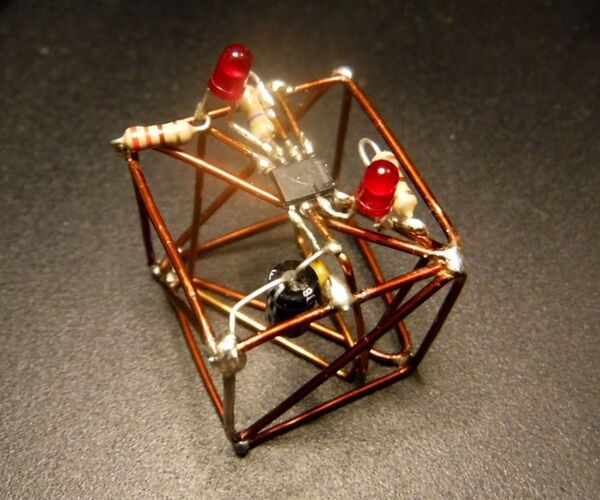
Dual Astable 555 Timer
"The 555 which comes in a number of technology variants (Bipolar & CMOS), single, dual elements and different package styles (SMD & DIL), and finds many uses in a variety of applications from timers, pulse generation and oscillators. All of these applications have one thing in common and that is a single output on pin 3 which can both source and sink current. A typical use for the 555 is as an Astable Oscillator with the 2 resistors version being the most referenced allowing duty cycle adjusting by the ratio of these 2 resistors.However, there is an alternative and simpler single resistor version if a ~50% duty cycle will suffice. By utilising this simpler version we can turn a single output Astable into a two output Astable Oscillator. So how is this achieved. Supplies: 555 Timer LED's x 2 220R resistors x 2 470k resistor." [...]
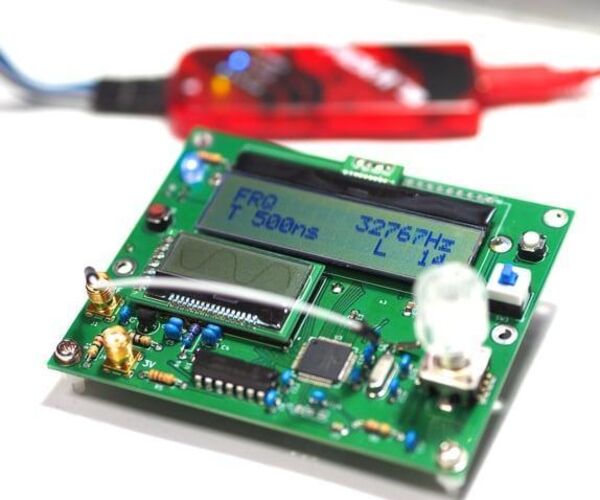
Frequency Counter With Waveform Display
"A frequency counter with a waveform display function. You can also specify which part of the input waveform you want to count. This can be made using a PIC with a built-in high speed ADC. However, since the pin spacing of the selected PIC is 0.5mm pitch, it was necessary to make a printed circuit board. Thinking of printing a simple chassis with a 3D printer, too. (But I also like bare PCBs..)" [...]

ESP8266 Webserver DHT11 Sensor and OLED Display
"ESP8266 DHT11 Temperature SensorThis Simple tutorial post shows how to interface the ESP8266 NodeMCU Development Board with DHT11 Digital humidity & Temperature sensor and 0.91 inch OLED display (12832 Pixel).The NodeMCU reads temperature and relative humidity values from the DHT11 sensor and prints it on OLED display, also you can get temperature and humidity values on mobile web browser. OLED Display Organic Light Emitting Diode (OLED) is a kind of Light Emitting Diode where a light emitting layer which is made of organic compound emits light when electric current is supplied. This layer is placed between two electrodes. This technology is used in display screens like computers, televisions, smartphones etc. OLED displays have their own light and dont need any backlight like in LCD, therefore they are power efficient and used with many microcontrollers. One more advantage of using OLED displays over LCD is of displaying large and better quality of graphics on OLEDs." [...]
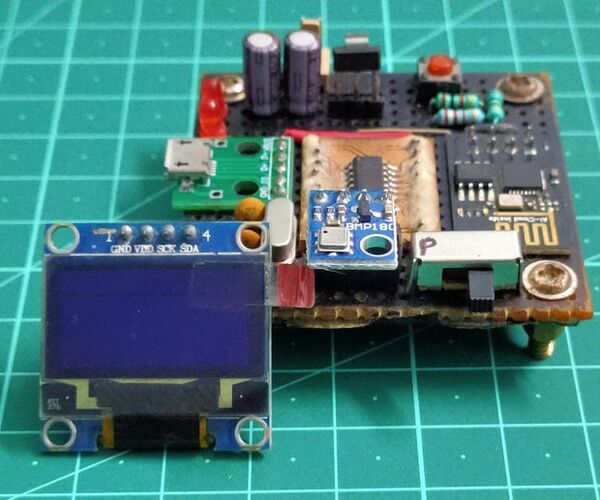
ESP8266-01 With Multiple I2C Devices?! || Exploring ESP8266:Part 2
"Hello all! This instructable happens to be part 2 of my ESP series where I continue to experiment and explore the various features of the ESP 8266-01 board. In the first part of the series I have mentioned the wonderful capability of this little board to support I2C communication. You can read more about this feature in Part 1: https://www.instructables.com/I2C-With-the-ESP8266... In this part of the series, we will look at the possibility of connecting multiple I2C devices and see wheather is board can handle the same. The second I2C device used in this project is the BMP 180, temperature, altitude and pressure sensor( more details about that in the later steps)." [...]
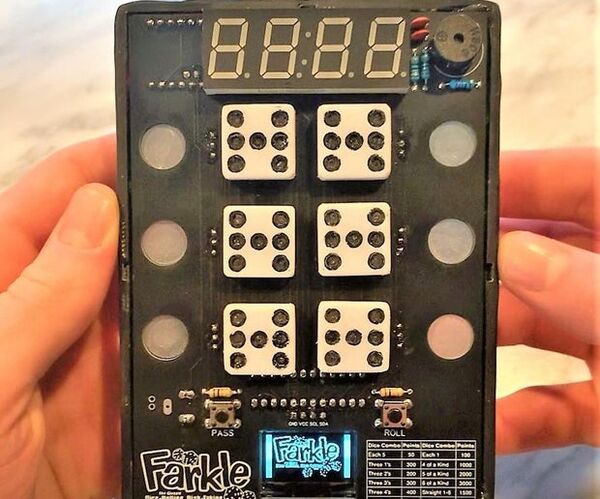
Farkle! Handheld PCB Game Console
"In this Instructable I will show you how I made my PCB Farkle Game! Farkle, also known as 10000, Zilch, 6 Dice, and Ten Thousand, is a fun and challenging dice game with multiple variations and scoring options. I first got the inspiration from my twin brother, Sunyecz06s Liars Dice PCB game in which he utilized a MAX7219 chip to roll 5 electronic LED dice. I thought his final product was awesome and wanted to create something utilizing similar components. Additionally, growing up, my family and I played the traditional Farkle game (with 6 dice, pen, and paper) quite a bit and we always had fun playing it, especially times when someone would actually Farkle during gameplay and wed all shout FAARRKKLEE! At some point during quarantine, I was looking for different games to play and I remembered Farkle." [...]
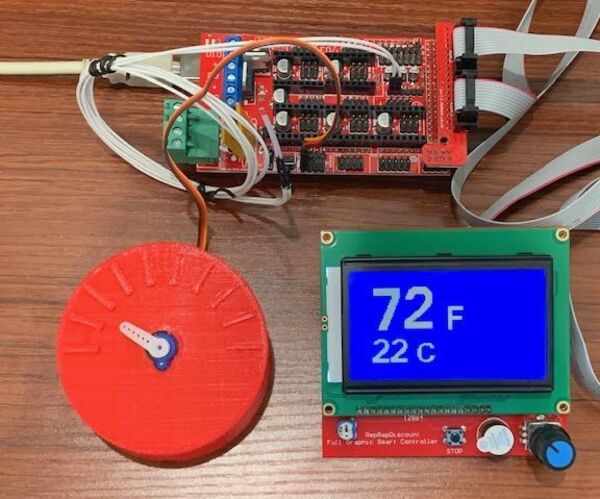
Hacking Arduino Mega/RAMPS 3D Printer Shield to Control Any Project
"Introduction The Arduino Mega and Ramps Shield combination is a popular hardware platform for controlling FFF 3D printers. The Arduino Mega 2560 R3, based on the ATmega2560 micro-controller, is a powerful MCU board with 54 digital I/O pins, 16 analog inputs, 256K flash memory, numerous serial comm options, and 6 timer/counters that can be used to perform tasks at precise intervals outside the main loop using interrupt service routines (ISRs). The RAMPS 1.4 shield takes advantage of these MEGA capabilities to control 3D printers. It offers: 5 stepper motor driver sockets 4 servo driver sockets 3 thermister inputs 6 end stop inputs 3 high current MOSFET driven heater/fan outputs SD Card reader inputs LCD Display connector Best of all, it is relatively inexpensive to purchase a kit containing an Arduino Mega, RAMPS 1.4, LCD display, stepper motor drivers, and cables. Just search for 'RAMPS 1.4 kit.' (Note: newer versions of RAMPS may be available when you read this instructable.)" [...]

ESP32 Smart Home System With Alexa App & Manual Switches
"In this IoT project, I have shown how to make IoT based Smart Home Automation Using Amazon Alexa & ESP32 to control 8 home appliances from the manual switch & Amazon Alexa App. If the internet is not available, then you can control the home appliances from manual switches. During the article, I have shown all the steps to make this smart home system. This ESP32 control smart relay has the following features: 1. Control home appliances with voice commands using Alexa 2. Control home appliances with manual switches." [...]

Logic Gates Demonstration Kit
"When teaching a Math Circle, I was discussing with the students various logic operations and logic gates. We went from basic AND and OR gates to constructing flip-flop circuit and full adder - using software simulation. I wanted to show them real electronics gates, so I started looking for a demonstration kit which would be functional: enough pieces to build something interesting such as flip-flop or adder easy to use clean-looking - breadboard with a rat's nest of wires doesn't make a good demonstration kit large enough so that it can be shown to a group of several students not too expensive: under $50 for the whole kit I couldn't find such a kit; the closest I found was this one from Sparkfun, but is still fails on several counts. So I decided to make my own, which meets all the requirements above and more. Here are some features of my kit: It uses custom black PCBs; to make it look nicer, I used surface-mounted components placing most components on the back contains 5 types of gates (AND, OR, XOR, NAND, NOT) plus a separate 3-bit input board is powered through USB-C connector each board is relatively large - 48x72mm - only slightly smaller than a credit card, with high contrast white on black marking and bright blue LED to indicate states boards are connected by a common 3-wire connectors, commonly used for servos and widely available boards have stick-on magnets on the back, allowing one to place them on a magnetic whiteboard or blackboard or any other magnetic surface - even refrigerator door! Using surface mounted components makes it more difficult to solder, but in this case, the components are few and not too small, so this makes a nice first SMD soldering kit for those wishing to learn SMD soldering." [...]

DIY ESP32 Camera Motor Shield - Wifi Camera Robot Car
"To design a PCB use Autodesk Eagle software, which is a CAD program specifically designed for making circuit boards. This software is free for 2-sided boards up to 80cm². This should be more than enough area for any hobby project.You can download Eagle from Autodesk's website, and you will also need to sign up for a free Autodesk account. You can download Eagle from Autodesk's website, and you will also need to sign up for a free Autodesk account. To learn how to design a custom printed circuit board for your prototype project. You can follow Circuit Board Design Class." [...]
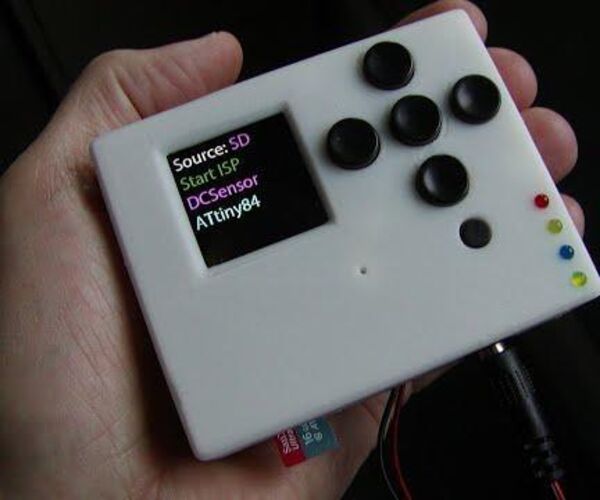
AVR SD Hex Loader ISP
"This project is all about getting your compiled sketch onto your target board without the need to have a connection to a computer running the Arduino IDE. The video demonstrates the operation of the loader. The first board being loaded in the video is my DCSensor (Dust Collector Sensor) board. The DCSensor binary is loaded via its ICSP connector is 3202 bytes. The second board being loaded is my DCController board. The DCController binary is loaded via its TTL Serial connector is 61258 bytes." [...]
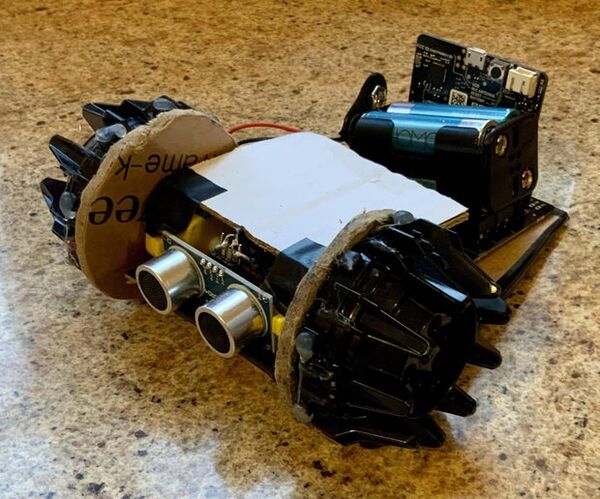
Mouse the Self-driving Robot
"Mouse is a simple maze solving robot to teach students and young engineers about robotics and the use of a micro-controllers. The robot uses a Micro:bit connected to a Kitronic motor diver board and an ultra-sonic sensor to find information and make a decision as a result. This project is designed with a simple and easy to understand program that allows the robot to drive itself and turn when it detects an object in its path. While creating this project I designed it so that the idea of the vehicle is easily changeable without having to change the hardware. I hope that anyone recreating this project will expand on my program and come up with new functionality. Other features that I tried was add RC features with the addition of a second Micro:bit that is used as the control panel and can send, receive and display data to the robot." [...]

Animated Led Star
"For this instructable I got the idea during a conversation with my brother and brother in law. My brother was playing with a Led strip, one meter long wooden strip with 144 WS2812B programmable leds on it, and my brother in law just really wanted to have one. So, I thought, "Time for a new project", let’s make him one. To make this project a bit more interesting I decided to build a star shape. 8 legs, 4 long with 20 leds and 4 shorter legs for 16 leds. Powered by a wall plug of 5V 3A." [...]

FPV in a Slot Car
"Why not combine two hobbies to one. Slot car and FPV :-D This is a remix of my chassis I use for SCX Compact DTM cars. I've modified it and made a canopy for the FPV-camera. " [...]

Ultra-Low Power Soil Monitor
"In an effort to counter my own forgetfulness to water the plant in my apartment and on my balcony, I tried myself on developing a soil moisture sensor device. Since I wanted it to run on my balcony, where I don’t have the means to connect everything up to a power socket, it needs to be battery-powered device. And because it is supposed to integrate with my Home Assistant it needs wireless connectivity as well and not just a simple indicator light for example. As sensors I came across these Capacitive Soil Moisture sensors, which are sold rather cheap, when sourced directly from China. They output an analog signal, which changes based on the capacitance of the surrounding material. The water contents of the soil gives enough of a change in it capacitance to change the senor’s reading." [...]
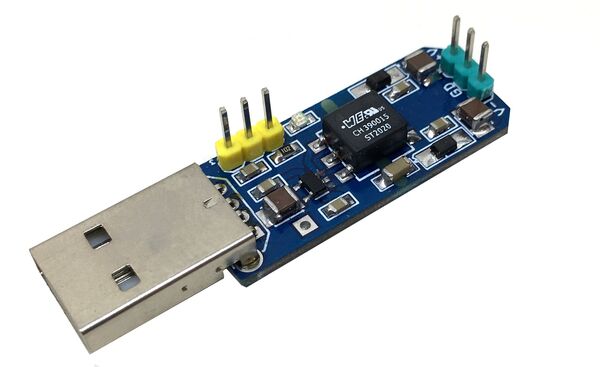
+/-18V Isolated DC-DC Converter Dual Supply Output from USB 5V Power Input
"This is a mini DC-DC converter with dual output from single 5V DC supply or USB power source (e.g., +/-18V from 5V/USB). The mini board will fit into small space and perform with high efficiency. Basically, the circuit transfers power from 5V/USB to the output side +/-18V with high isolation, without a direct connection between 5V/USB power and output. The power isolation prevents ground loops and provides high noise immunity between input and output. The project is based on SN6501 chip, which is oscillator/power-driver, is specifically designed for small factor devices. The device drives a low profile, center-tapped transformer primary from 5V/USB power and secondary side provides unregulated dual output which can be further regulated as per requirement (e.g., +/-5V, +/-12V)." [...]
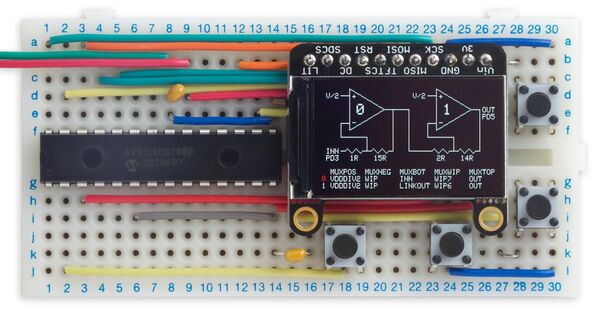
Pocket Op Amp Lab
"This is a self-contained tool to allow you to experiment with the configurable op amps provided in the new AVR DB-series processors from Microchip. It shows the configuration as a circuit diagram on the display, and lets you reconfigure it by selecting options from on-screen menus. The display is dynamically updated to reflect the configuration you have selected It's based on an Adafruit 240x135 colour TFT display, and an AVR128DB28 microcontroller. This provides two configurable op amps, each of which can be used to amplify low-level signals up to logic levels, or to process the output from the chip's DAC output. As you press the buttons to change a menu option, the op amp settings are also updated dynamically. So, for example, if you're using an op amp to amplify an audio signal you'll hear the volume change as you step between the MUXWIP options, which determine the op amp gain." [...]

TinyPocketRadio - FM Stereo Radio based on ATtiny13A
"TinyPocketRadio is a simple FM stereo radio based on ATtiny13A and RDA5807MP. It's powered by a CR2032 coin cell battery and can drive 32 Ohm headphones via the 3.5 mm audio plug. The board size is 38 x 23 mm. It has a power switch and three buttons: "Channel+", Volume-" and "Volume+ ". The low-cost RDA5807MP is a single-chip broadcast FM stereo radio tuner with fully integrated synthesizer, IF selectivity, RDS/RBDS and MPX decoder. The tuner uses the CMOS process, support multi-interface and require the least external component." [...]

TinyDecoder - IR Remote Receiver and NEC Decoder based on ATtiny13A
"ATtiny13A receives IR signal via TSOP4838, decodes the signal (NEC protocol) and displays address and command (hex values) on an SSD1306 128x32 OLED display. The device is powered by a 1220 coin cell battery. Please remember that only the rechargeable LIR1220 Li-Ion batteries work. The "normal" CR1220s don't deliver enough power. The IR NEC decoding function utilizes timer0 to measure the burst and pause lengths of the signal. The timer is automatically started and stopped or reset by the IR receiver via a pin change interrupt." [...]
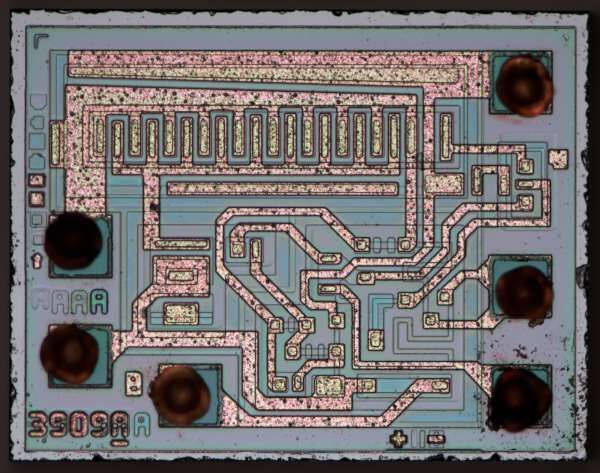
Reverse-engineering a low-power LED flasher chip
"How do you make an LED blink? A vintage way is the LM3909, a chip from 1975 that can flash an LED for a year from a single flashlight battery. This chip has some surprising features, such as a charge pump that lets you power a 2-volt LED from a 1.5-volt battery. This IC was designed for simplicity, using just an LED, external capacitor, and battery. In this blog post, I reverse-engineer its silicon die. The photo below (from Zeptobars) shows the die under a microscope." [...]

Building an Air Filtration System for a 3D Printer
"How I used a microcontroller, a fan, and a bunch of sensors to create a smart filtration system. I was thinking of projects to work on, and I thought, gee, it would be nice if our 3D printer didn’t kill us 1. I had researched the potential health side effects of owning a 3D printer when I bought it - it turns out they can malfunction and catch fire or release harmful chemicals into the air - but I made excuses. I’m only printing in Polyactic Acid (PLA), one of the least harmful filaments - it’s probably fine. Sure, maybe it releases some tiny plastic into the air, but it’s a big room, and sometimes I keep the windows open. Our smoke detectors are brand new and well tested." [...]
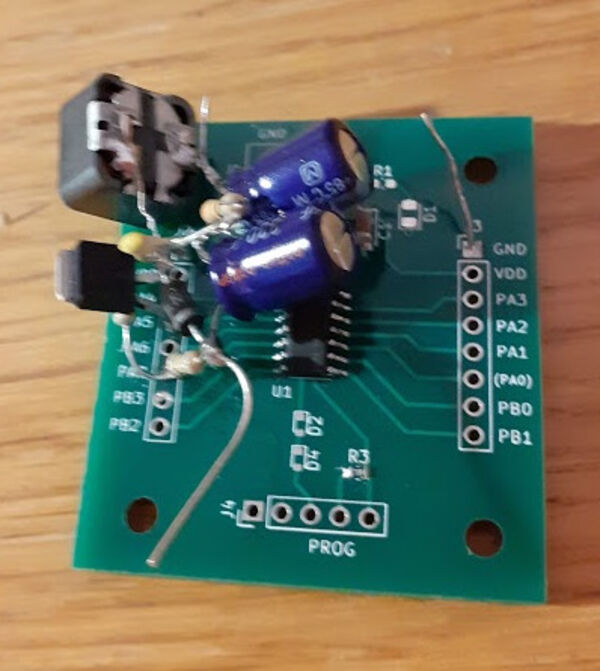
Boost regulator with ATtiny
"When Microchip bought Atmel I was afraid that they would discontinue further development of the AVR MCUs and instead only promote their PIC-devices. But it seems this worry was unjustified. New series of ATtinies and ATmegas have been released and these new devices are packed with very useful periferals. At the same time the price of the newer devices are substantially lower than the older ones. Of particular interest to me is the Event System and the Configurable Custom Logic (CCL) block that makes it possible to route signals between peripherals and pins without having to go through any CPU processing. This opens up for applications like software configurable switch-mode regulators for voltage translation (step-up/boost, step-down/buck, flyback etc.)." [...]
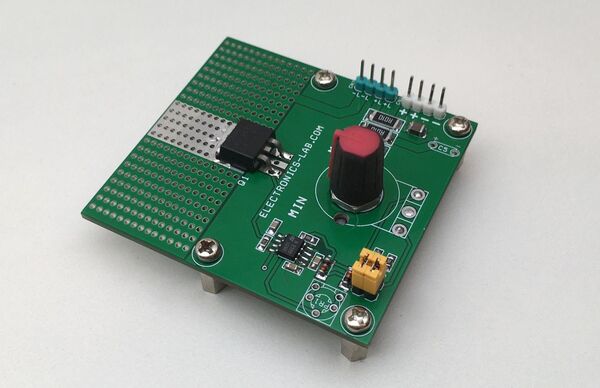
60W LED Dimmer for 12V LEDs using 555 Timer
"The project shown here is a cheap 60W LED dimmer for 12V LEDs/12V LED strips. The circuit is based on the very popular, versatile, and low-cost 555 timer IC, NE555 IC generates a PWM signal and IRF540 MOSFET works as output driver for the LEDs. In this circuit the 555 IC used in an astable multivibrator configuration to generate the PWM, by controlling the charging and discharging of the timing of capacitor C3, using D2, D3 and PR1. Potentiometer R7 is provided to control the intensity of LED connected to connector CN2, Connector CN1 provided to power the project with 12V DC. D1 is power indicator LED. Large thermal area provided as heatsink to cool down the MOSFET." [...]
That's all Folks!



